Massachusetts Institute of Technology
Massachusetts Institute of Technology (MIT) is a private research university in Cambridge, Massachusetts. The institute is a land-grant, sea-grant, and space-grant university, with an urban campus that extends more than a mile (1.6 km) alongside the Charles River. The institute also encompasses a number of major off-campus facilities such as the MIT Lincoln Laboratory, the Bates Center, and the Haystack Observatory, as well as affiliated laboratories such as the Broad and Whitehead Institutes. Founded in 1861 in response to the increasing industrialization of the United States, MIT adopted a European polytechnic university model and stressed laboratory instruction in applied science and engineering. It has since played a key role in the development of many aspects of modern science, engineering, mathematics, and technology, and is widely known for its innovation and academic strength.[10][11][12][13]
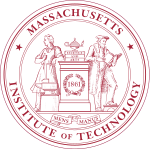 | |
| Motto | Mens et Manus (Latin) |
|---|---|
Motto in English | Mind and Hand[1] |
| Type | Private Land grant Sea grant Space grant |
| Established | April 10, 1861 |
Academic affiliations | AAU AICUM AITU APLU COFHE NAICU[2] URA 568 Group |
| Endowment | $17.57 billion (2019)[3] |
| Chancellor | Cynthia Barnhart |
| President | L. Rafael Reif |
| Provost | Martin A. Schmidt |
Academic staff | 1,074[4] |
| Students | 11,520 (Fall 2019)[5] |
| Undergraduates | 4,530 (Fall 2019)[5] |
| Postgraduates | 6,990 (Fall 2019)[5] |
| Location | , United States 42.360°N 71.092°W |
| Campus | Urban, 166 acres (67.2 ha)[6] |
| Newspaper | The Tech |
| Colors | Cardinal Red and Silver Gray[7][8] |
| Nickname | Engineers |
Sporting affiliations | NCAA Division III – NEWMAC, NEFC, Pilgrim League Division I – EARC and EAWRC (rowing) |
| Mascot | Tim the Beaver[9] |
| Website | web |
 | |
As of October 2019, 96 Nobel laureates, 26 Turing Award winners, and 8 Fields Medalists have been affiliated with MIT as alumni, faculty members, or researchers.[14] In addition, 58 National Medal of Science recipients, 29 National Medals of Technology and Innovation recipients, 50 MacArthur Fellows,[15] 73 Marshall Scholars,[16] 48 Rhodes Scholars,[17] 41 astronauts,[18] and 16 Chief Scientists of the U.S. Air Force have been affiliated with MIT. The school also has a strong entrepreneurial culture.[19][20] MIT is a member of the Association of American Universities (AAU).[21]
History
Foundation and vision
.jpg)
.png)
In 1859, a proposal was submitted to the Massachusetts General Court to use newly filled lands in Back Bay, Boston for a "Conservatory of Art and Science", but the proposal failed.[22][23] A charter for the incorporation of the Massachusetts Institute of Technology, proposed by William Barton Rogers, was signed by John Albion Andrew, the governor of Massachusetts, on April 10, 1861.[24]
Rogers, a professor from the University of Virginia, wanted to establish an institution to address rapid scientific and technological advances.[25][26] He did not wish to found a professional school, but a combination with elements of both professional and liberal education,[27] proposing that:
The true and only practicable object of a polytechnic school is, as I conceive, the teaching, not of the minute details and manipulations of the arts, which can be done only in the workshop, but the inculcation of those scientific principles which form the basis and explanation of them, and along with this, a full and methodical review of all their leading processes and operations in connection with physical laws.[28]
The Rogers Plan reflected the German research university model, emphasizing an independent faculty engaged in research, as well as instruction oriented around seminars and laboratories.[29][30]
Early developments
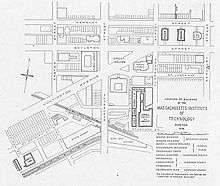
.tiff.jpg)
Two days after MIT was chartered, the first battle of the Civil War broke out. After a long delay through the war years, MIT's first classes were held in the Mercantile Building in Boston in 1865.[31] The new institute was founded as part of the Morrill Land-Grant Colleges Act to fund institutions "to promote the liberal and practical education of the industrial classes" and was a land-grant school.[32][33] In 1863 under the same act, the Commonwealth of Massachusetts founded the Massachusetts Agricultural College, which developed as the University of Massachusetts Amherst. In 1866, the proceeds from land sales went toward new buildings in the Back Bay.[34]
MIT was informally called "Boston Tech".[34] The institute adopted the European polytechnic university model and emphasized laboratory instruction from an early date.[29] Despite chronic financial problems, the institute saw growth in the last two decades of the 19th century under President Francis Amasa Walker.[35] Programs in electrical, chemical, marine, and sanitary engineering were introduced,[36][37] new buildings were built, and the size of the student body increased to more than one thousand.[35]
The curriculum drifted to a vocational emphasis, with less focus on theoretical science.[38] The fledgling school still suffered from chronic financial shortages which diverted the attention of the MIT leadership. During these "Boston Tech" years, MIT faculty and alumni rebuffed Harvard University president (and former MIT faculty) Charles W. Eliot's repeated attempts to merge MIT with Harvard College's Lawrence Scientific School.[39] There would be at least six attempts to absorb MIT into Harvard.[40] In its cramped Back Bay location, MIT could not afford to expand its overcrowded facilities, driving a desperate search for a new campus and funding. Eventually, the MIT Corporation approved a formal agreement to merge with Harvard, over the vehement objections of MIT faculty, students, and alumni.[40] However, a 1917 decision by the Massachusetts Supreme Judicial Court effectively put an end to the merger scheme.[40]
.jpg)
In 1916, the MIT administration and the MIT charter crossed the Charles River on the ceremonial barge Bucentaur built for the occasion,[41][42] to signify MIT's move to a spacious new campus largely consisting of filled land on a one-mile-long (1.6 km) tract along the Cambridge side of the Charles River.[43][44] The neoclassical "New Technology" campus was designed by William W. Bosworth[45] and had been funded largely by anonymous donations from a mysterious "Mr. Smith", starting in 1912. In January 1920, the donor was revealed to be the industrialist George Eastman of Rochester, New York, who had invented methods of film production and processing, and founded Eastman Kodak. Between 1912 and 1920, Eastman donated $20 million ($236.6 million in 2015 dollars) in cash and Kodak stock to MIT.[46]
In 1931 Stanislav Shumovsky enrolled. He later communicated much technical information on aviation to the Soviet Union. Other MIT spies sent other secrets about American technology, eventually including atomic bomb secrets.[47]
Curricular reforms
In the 1930s, President Karl Taylor Compton and Vice-President (effectively Provost) Vannevar Bush emphasized the importance of pure sciences like physics and chemistry and reduced the vocational practice required in shops and drafting studios.[48] The Compton reforms "renewed confidence in the ability of the Institute to develop leadership in science as well as in engineering".[49] Unlike Ivy League schools, MIT catered more to middle-class families, and depended more on tuition than on endowments or grants for its funding.[50] The school was elected to the Association of American Universities in 1934.[51]
Still, as late as 1949, the Lewis Committee lamented in its report on the state of education at MIT that "the Institute is widely conceived as basically a vocational school", a "partly unjustified" perception the committee sought to change. The report comprehensively reviewed the undergraduate curriculum, recommended offering a broader education, and warned against letting engineering and government-sponsored research detract from the sciences and humanities.[52][53] The School of Humanities, Arts, and Social Sciences and the MIT Sloan School of Management were formed in 1950 to compete with the powerful Schools of Science and Engineering. Previously marginalized faculties in the areas of economics, management, political science, and linguistics emerged into cohesive and assertive departments by attracting respected professors and launching competitive graduate programs.[54][55] The School of Humanities, Arts, and Social Sciences continued to develop under the successive terms of the more humanistically oriented presidents Howard W. Johnson and Jerome Wiesner between 1966 and 1980.[56]
Defense research
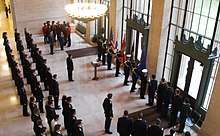
MIT's involvement in military science surged during World War II. In 1941, Vannevar Bush was appointed head of the federal Office of Scientific Research and Development and directed funding to only a select group of universities, including MIT.[57] Engineers and scientists from across the country gathered at MIT's Radiation Laboratory, established in 1940 to assist the British military in developing microwave radar. The work done there significantly affected both the war and subsequent research in the area.[58] Other defense projects included gyroscope-based and other complex control systems for gunsight, bombsight, and inertial navigation under Charles Stark Draper's Instrumentation Laboratory;[59][60] the development of a digital computer for flight simulations under Project Whirlwind;[61] and high-speed and high-altitude photography under Harold Edgerton.[62][63] By the end of the war, MIT became the nation's largest wartime R&D contractor (attracting some criticism of Bush),[57] employing nearly 4000 in the Radiation Laboratory alone[58] and receiving in excess of $100 million ($1.2 billion in 2015 dollars) before 1946.[49] Work on defense projects continued even after then. Post-war government-sponsored research at MIT included SAGE and guidance systems for ballistic missiles and Project Apollo.[64]
—MIT president James Rhyne Killian
These activities affected MIT profoundly. A 1949 report noted the lack of "any great slackening in the pace of life at the Institute" to match the return to peacetime, remembering the "academic tranquility of the prewar years", though acknowledging the significant contributions of military research to the increased emphasis on graduate education and rapid growth of personnel and facilities.[65] The faculty doubled and the graduate student body quintupled during the terms of Karl Taylor Compton, president of MIT between 1930 and 1948; James Rhyne Killian, president from 1948 to 1957; and Julius Adams Stratton, chancellor from 1952 to 1957, whose institution-building strategies shaped the expanding university. By the 1950s, MIT no longer simply benefited the industries with which it had worked for three decades, and it had developed closer working relationships with new patrons, philanthropic foundations and the federal government.[66]
In late 1960s and early 1970s, student and faculty activists protested against the Vietnam War and MIT's defense research.[67][68] In this period MIT's various departments were researching helicopters, smart bombs and counterinsurgency techniques for the war in Vietnam as well as guidance systems for nuclear missiles.[69] The Union of Concerned Scientists was founded on March 4, 1969 during a meeting of faculty members and students seeking to shift the emphasis on military research toward environmental and social problems.[70] MIT ultimately divested itself from the Instrumentation Laboratory and moved all classified research off-campus to the MIT Lincoln Laboratory facility in 1973 in response to the protests.[71][72] The student body, faculty, and administration remained comparatively unpolarized during what was a tumultuous time for many other universities.[67] Johnson was seen to be highly successful in leading his institution to "greater strength and unity" after these times of turmoil.[73] However six MIT students were sentenced to prison terms at this time and some former student leaders, such as Michael Albert and George Katsiaficas, are still indignant about MIT's role in military research and its suppression of these protests.[74] (Richard Leacock's film, November Actions, records some of these tumultuous events.[75])
In the 1980s, there was more controversy at MIT over its involvement in SDI (space weaponry) and CBW (chemical and biological warfare) research.[76] More recently, MIT's research for the military has included work on robots, drones and 'battle suits'.[77]
Recent history
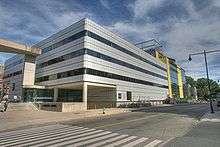
MIT has kept pace with and helped to advance the digital age. In addition to developing the predecessors to modern computing and networking technologies,[78][79] students, staff, and faculty members at Project MAC, the Artificial Intelligence Laboratory, and the Tech Model Railroad Club wrote some of the earliest interactive computer video games like Spacewar! and created much of modern hacker slang and culture.[80] Several major computer-related organizations have originated at MIT since the 1980s: Richard Stallman's GNU Project and the subsequent Free Software Foundation were founded in the mid-1980s at the AI Lab; the MIT Media Lab was founded in 1985 by Nicholas Negroponte and Jerome Wiesner to promote research into novel uses of computer technology;[81] the World Wide Web Consortium standards organization was founded at the Laboratory for Computer Science in 1994 by Tim Berners-Lee;[82] the OpenCourseWare project has made course materials for over 2,000 MIT classes available online free of charge since 2002;[83] and the One Laptop per Child initiative to expand computer education and connectivity to children worldwide was launched in 2005.[84]
MIT was named a sea-grant college in 1976 to support its programs in oceanography and marine sciences and was named a space-grant college in 1989 to support its aeronautics and astronautics programs.[85][86] Despite diminishing government financial support over the past quarter century, MIT launched several successful development campaigns to significantly expand the campus: new dormitories and athletics buildings on west campus; the Tang Center for Management Education; several buildings in the northeast corner of campus supporting research into biology, brain and cognitive sciences, genomics, biotechnology, and cancer research; and a number of new "backlot" buildings on Vassar Street including the Stata Center.[87] Construction on campus in the 2000s included expansions of the Media Lab, the Sloan School's eastern campus, and graduate residences in the northwest.[88][89] In 2006, President Hockfield launched the MIT Energy Research Council to investigate the interdisciplinary challenges posed by increasing global energy consumption.[90]
In 2001, inspired by the open source and open access movements,[91] MIT launched OpenCourseWare to make the lecture notes, problem sets, syllabi, exams, and lectures from the great majority of its courses available online for no charge, though without any formal accreditation for coursework completed.[92] While the cost of supporting and hosting the project is high,[93] OCW expanded in 2005 to include other universities as a part of the OpenCourseWare Consortium, which currently includes more than 250 academic institutions with content available in at least six languages.[94] In 2011, MIT announced it would offer formal certification (but not credits or degrees) to online participants completing coursework in its "MITx" program, for a modest fee.[95] The "edX" online platform supporting MITx was initially developed in partnership with Harvard and its analogous "Harvardx" initiative. The courseware platform is open source, and other universities have already joined and added their own course content.[96] In March 2009 the MIT faculty adopted an open-access policy to make its scholarship publicly accessible online.[97]
MIT has its own police force. Three days after the Boston Marathon bombing of April 2013, MIT Police patrol officer Sean Collier was fatally shot by the suspects Dzhokhar and Tamerlan Tsarnaev, setting off a violent manhunt that shut down the campus and much of the Boston metropolitan area for a day.[98] One week later, Collier's memorial service was attended by more than 10,000 people, in a ceremony hosted by the MIT community with thousands of police officers from the New England region and Canada.[99][100][101] On November 25, 2013, MIT announced the creation of the Collier Medal, to be awarded annually to "an individual or group that embodies the character and qualities that Officer Collier exhibited as a member of the MIT community and in all aspects of his life". The announcement further stated that "Future recipients of the award will include those whose contributions exceed the boundaries of their profession, those who have contributed to building bridges across the community, and those who consistently and selflessly perform acts of kindness".[102][103][104]
In September 2017, the school announced the creation of an artificial intelligence research lab called the MIT-IBM Watson AI Lab. IBM will spend $240 million over the next decade, and the lab will be staffed by MIT and IBM scientists.[105] In October 2018 MIT announced that it would open a new Schwarzman College of Computing dedicated to the study of artificial intelligence, named after lead donor and The Blackstone Group CEO Stephen Schwarzman. The focus of the new college is to study not just AI, but interdisciplinary AI education, and how AI can be used in fields as diverse as history and biology. The cost of buildings and new faculty for the new college is expected to be $1 billion upon completion.[106]
Over the course of 20 years, MIT received approximately $800,000 via foundations controlled by Jeffrey Epstein,[107] convicted sex offender charged with the sex trafficking and sexual abuse of minors. All of those gifts went either to the MIT Media Lab or to Professor Seth Lloyd. Both Lloyd and former Media Lab Director Joi Ito have made public statements apologizing to Jeffrey Epstein's victims and others for judgments made over a series of years.[108][109] Ito resigned from his position as Media Lab Director and professor, but Lloyd did not.[110][111] Lloyd has been placed on temporary leave and there have been several protests from the MIT community urging for his resignation.
Campus
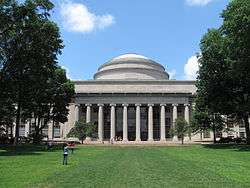
MIT's 166-acre (67.2 ha) campus in the city of Cambridge spans approximately a mile along the north side of the Charles River basin.[6] The campus is divided roughly in half by Massachusetts Avenue, with most dormitories and student life facilities to the west and most academic buildings to the east. The bridge closest to MIT is the Harvard Bridge, which is known for being marked off in a non-standard unit of length – the smoot.[112][113]
The Kendall/MIT MBTA Red Line station is located on the northeastern edge of the campus, in Kendall Square. The Cambridge neighborhoods surrounding MIT are a mixture of high tech companies occupying both modern office and rehabilitated industrial buildings, as well as socio-economically diverse residential neighborhoods.[114][115] In early 2016, MIT presented its updated Kendall Square Initiative to the City of Cambridge, with plans for mixed-use educational, retail, residential, startup incubator, and office space in a dense high-rise transit-oriented development plan.[116][117] The MIT Museum will eventually be moved immediately adjacent to a Kendall Square subway entrance, joining the List Visual Arts Center on the eastern end of the campus.[117][118]
Each building at MIT has a number (possibly preceded by a W, N, E, or NW) designation and most have a name as well. Typically, academic and office buildings are referred to primarily by number while residence halls are referred to by name. The organization of building numbers roughly corresponds to the order in which the buildings were built and their location relative (north, west, and east) to the original center cluster of Maclaurin buildings.[119] Many of the buildings are connected above ground as well as through an extensive network of tunnels, providing protection from the Cambridge weather as well as a venue for roof and tunnel hacking.[120][121]
MIT's on-campus nuclear reactor[122] is one of the most powerful university-based nuclear reactors in the United States. The prominence of the reactor's containment building in a densely populated area has been controversial,[123] but MIT maintains that it is well-secured.[124] In 1999 Bill Gates donated US$20 million to MIT for the construction of a computer laboratory named the "William H. Gates Building", and designed by architect Frank Gehry. While Microsoft had previously given financial support to the institution, this was the first personal donation received from Gates.[125]
MIT Nano, also known as Building 12, is an interdisciplinary facility for nanoscale research. Its 100,000-square-foot (9,300 m2) cleanroom and research space, visible through expansive glass facades, is the largest research facility of its kind in the nation.[126] With a cost of US$400 million, it is also one of the costliest buildings on campus. The facility also provides state-of-the-art nanoimaging capabilities with vibration damped imaging and metrology suites sitting atop a 5-million-pound (2,300,000 kg) slab of concrete underground.[127]
Other notable campus facilities include a pressurized wind tunnel for testing aerodynamic research, a towing tank for testing ship and ocean structure designs, and Alcator C-Mod, the largest fusion device operated by any university.[128][129] MIT's campus-wide wireless network was completed in the fall of 2005 and consists of nearly 3,000 access points covering 9.4 million square feet (870,000 m2) of campus.[130]
In 2001, the Environmental Protection Agency sued MIT for violating the Clean Water Act and the Clean Air Act with regard to its hazardous waste storage and disposal procedures.[131] MIT settled the suit by paying a $155,000 fine and launching three environmental projects.[132] In connection with capital campaigns to expand the campus, the Institute has also extensively renovated existing buildings to improve their energy efficiency. MIT has also taken steps to reduce its environmental impact by running alternative fuel campus shuttles, subsidizing public transportation passes, and building a low-emission cogeneration plant that serves most of the campus electricity, heating, and cooling requirements.[133]
The MIT Police with state and local authorities, in the 2009–2011 period, have investigated reports of 12 forcible sex offenses, 6 robberies, 3 aggravated assaults, 164 burglaries, 1 case of arson, and 4 cases of motor vehicle theft on campus; affecting a community of around 22,000 students and employees.
MIT has substantial commercial real estate holdings in Cambridge on which it pays property taxes, plus an additional voluntary payment in lieu of taxes (PILOT) on academic buildings which are legally tax-exempt. As of 2017, it is the largest taxpayer in the city, contributing approximately 14% of the city's annual revenues.[134] Holdings include Technology Square, parts of Kendall Square, and many properties in Cambridgeport and Area 4 neighboring the educational buildings.[135] The land is held for investment purposes and potential long-term expansion.
Architecture
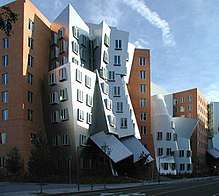
MIT's School of Architecture, now the School of Architecture and Planning, was the first in the United States,[136] and it has a history of commissioning progressive buildings.[137][138] The first buildings constructed on the Cambridge campus, completed in 1916, are sometimes called the "Maclaurin buildings" after Institute president Richard Maclaurin who oversaw their construction. Designed by William Welles Bosworth, these imposing buildings were built of reinforced concrete, a first for a non-industrial – much less university – building in the US.[139] Bosworth's design was influenced by the City Beautiful Movement of the early 1900s[139] and features the Pantheon-esque Great Dome housing the Barker Engineering Library. The Great Dome overlooks Killian Court, where graduation ceremonies are held each year. The friezes of the limestone-clad buildings around Killian Court are engraved with the names of important scientists and philosophers.[lower-alpha 1] The spacious Building 7 atrium at 77 Massachusetts Avenue is regarded as the entrance to the Infinite Corridor and the rest of the campus.[115]
Alvar Aalto's Baker House (1947), Eero Saarinen's MIT Chapel and Kresge Auditorium (1955), and I.M. Pei's Green, Dreyfus, Landau, and Wiesner buildings represent high forms of post-war modernist architecture.[142][143][144] More recent buildings like Frank Gehry's Stata Center (2004), Steven Holl's Simmons Hall (2002), Charles Correa's Building 46 (2005), and Fumihiko Maki's Media Lab Extension (2009) stand out among the Boston area's classical architecture and serve as examples of contemporary campus "starchitecture".[137][145] These buildings have not always been well received;[146][147] in 2010, The Princeton Review included MIT in a list of twenty schools whose campuses are "tiny, unsightly, or both".[148]
Housing
Undergraduates are guaranteed four-year housing in one of MIT's 10 undergraduate dormitories.[149] Those living on campus can receive support and mentoring from live-in graduate student tutors, resident advisors, and faculty housemasters.[150] Because housing assignments are made based on the preferences of the students themselves, diverse social atmospheres can be sustained in different living groups; for example, according to the Yale Daily News staff's The Insider's Guide to the Colleges, 2010, "The split between East Campus and West Campus is a significant characteristic of MIT. East Campus has gained a reputation as a thriving counterculture."[151] MIT also has 5 dormitories for single graduate students and 2 apartment buildings on campus for married student families.[152]
MIT has an active Greek and co-op housing system, including thirty-six fraternities, sororities, and independent living groups (FSILGs).[153] As of 2015, 98% of all undergraduates lived in MIT-affiliated housing; 54% of the men participated in fraternities and 20% of the women were involved in sororities.[154] Most FSILGs are located across the river in Back Bay near where MIT was founded, and there is also a cluster of fraternities on MIT's West Campus that face the Charles River Basin.[155] After the 1997 alcohol-related death of Scott Krueger, a new pledge at the Phi Gamma Delta fraternity, MIT required all freshmen to live in the dormitory system starting in 2002.[156] Because FSILGs had previously housed as many as 300 freshmen off-campus, the new policy could not be implemented until Simmons Hall opened in that year.[157]
In 2013–2014, MIT abruptly closed and then demolished undergrad dorm Bexley Hall, citing extensive water damage that made repairs infeasible. In 2017, MIT shut down Senior House after a century of service as an undergrad dorm. That year, MIT administrators released data showing just 60% of Senior House residents had graduated in four years. Campus-wide, the four-year graduation rate is 84% (the cumulative graduation rate is significantly higher).[158]
Organization and administration
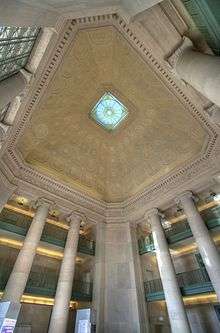
MIT is chartered as a non-profit organization and is owned and governed by a privately appointed board of trustees known as the MIT Corporation.[159] The current board consists of 43 members elected to five-year terms,[160] 25 life members who vote until their 75th birthday,[161] 3 elected officers (President, Treasurer, and Secretary),[162] and 4 ex officio members (the president of the alumni association, the Governor of Massachusetts, the Massachusetts Secretary of Education, and the Chief Justice of the Massachusetts Supreme Judicial Court).[163][164] The board is chaired by Robert Millard, a co-founder of L-3 Communications Holdings.[165][166] The Corporation approves the budget, new programs, degrees and faculty appointments, and elects the President to serve as the chief executive officer of the university and preside over the Institute's faculty.[115][167] MIT's endowment and other financial assets are managed through a subsidiary called MIT Investment Management Company (MITIMCo).[168] Valued at $16.4 billion in 2018, MIT's endowment was then the sixth-largest among American colleges and universities.[169]
MIT has five schools (Science, Engineering, Architecture and Planning, Management, and Humanities, Arts, and Social Sciences) and one college (Schwarzman College of Computing), but no schools of law or medicine.[170][lower-alpha 2][172] While faculty committees assert substantial control over many areas of MIT's curriculum, research, student life, and administrative affairs,[173] the chair of each of MIT's 32 academic departments reports to the dean of that department's school, who in turn reports to the Provost under the President.[174] The current president is L. Rafael Reif, who formerly served as provost under President Susan Hockfield, the first woman to hold the post.[175][176]
Academics
MIT is a large, highly residential, research university with a majority of enrollments in graduate and professional programs.[177] The university has been accredited by the New England Association of Schools and Colleges since 1929.[178] MIT operates on a 4–1–4 academic calendar with the fall semester beginning after Labor Day and ending in mid-December, a 4-week "Independent Activities Period" in the month of January, and the spring semester commencing in early February and ceasing in late May.[179]
MIT students refer to both their majors and classes using numbers or acronyms alone.[180] Departments and their corresponding majors are numbered in the approximate order of their foundation; for example, Civil and Environmental Engineering is Course 1, while Linguistics and Philosophy is Course 24.[181] Students majoring in Electrical Engineering and Computer Science (EECS), the most popular department, collectively identify themselves as "Course 6". MIT students use a combination of the department's course number and the number assigned to the class to identify their subjects; for instance, the introductory calculus-based classical mechanics course is simply "8.01" at MIT.[182][lower-alpha 3]
Undergraduate program
The four-year, full-time undergraduate program maintains a balance between professional majors and those in the arts and sciences, and has been dubbed "most selective" by U.S. News,[185] admitting few transfer students[177] and 6.7% of its applicants in the 2017–2018 admissions cycle.[186] MIT offers 44 undergraduate degrees across its five schools.[187] In the 2017–2018 academic year, 1,045 bachelor of science degrees (abbreviated "SB") were granted, the only type of undergraduate degree MIT now awards.[188][189] In the 2011 fall term, among students who had designated a major, the School of Engineering was the most popular division, enrolling 63% of students in its 19 degree programs, followed by the School of Science (29%), School of Humanities, Arts, & Social Sciences (3.7%), Sloan School of Management (3.3%), and School of Architecture and Planning (2%). The largest undergraduate degree programs were in Electrical Engineering and Computer Science (Course 6–2), Computer Science and Engineering (Course 6–3), Mechanical Engineering (Course 2), Physics (Course 8), and Mathematics (Course 18).[183]
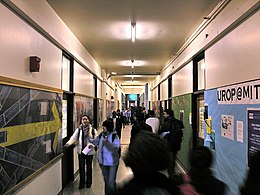
All undergraduates are required to complete a core curriculum called the General Institute Requirements (GIRs).[190] The Science Requirement, generally completed during freshman year as prerequisites for classes in science and engineering majors, comprises two semesters of physics, two semesters of calculus, one semester of chemistry, and one semester of biology. There is a Laboratory Requirement, usually satisfied by an appropriate class in a course major. The Humanities, Arts, and Social Sciences (HASS) Requirement consists of eight semesters of classes in the humanities, arts, and social sciences, including at least one semester from each division as well as the courses required for a designated concentration in a HASS division. Under the Communication Requirement, two of the HASS classes, plus two of the classes taken in the designated major must be "communication-intensive",[191] including "substantial instruction and practice in oral presentation".[192] Finally, all students are required to complete a swimming test;[193] non-varsity athletes must also take four quarters of physical education classes.[190]
Most classes rely on a combination of lectures, recitations led by associate professors or graduate students, weekly problem sets ("p-sets"), and periodic quizzes or tests. While the pace and difficulty of MIT coursework has been compared to "drinking from a fire hose",[194][195][196] the freshmen retention rate at MIT is similar to other research universities.[185] The "pass/no-record" grading system relieves some pressure for first-year undergraduates. For each class taken in the fall term, freshmen transcripts will either report only that the class was passed, or otherwise not have any record of it. In the spring term, passing grades (A, B, C) appear on the transcript while non-passing grades are again not recorded.[197] (Grading had previously been "pass/no record" all freshman year, but was amended for the Class of 2006 to prevent students from gaming the system by completing required major classes in their freshman year.[198]) Also, freshmen may choose to join alternative learning communities, such as Experimental Study Group, Concourse, or Terrascope.[197]
In 1969, Margaret MacVicar founded the Undergraduate Research Opportunities Program (UROP) to enable undergraduates to collaborate directly with faculty members and researchers. Students join or initiate research projects ("UROPs") for academic credit, pay, or on a volunteer basis through postings on the UROP website or by contacting faculty members directly.[199] A substantial majority of undergraduates participate.[200][201] Students often become published, file patent applications, and/or launch start-up companies based upon their experience in UROPs.[202][203]
In 1970, the then-Dean of Institute Relations, Benson R. Snyder, published The Hidden Curriculum, arguing that education at MIT was often slighted in favor of following a set of unwritten expectations and that graduating with good grades was more often the product of figuring out the system rather than a solid education. The successful student, according to Snyder, was the one who was able to discern which of the formal requirements were to be ignored in favor of which unstated norms. For example, organized student groups had compiled "course bibles"—collections of problem-set and examination questions and answers for later students to use as references. This sort of gamesmanship, Snyder argued, hindered development of a creative intellect and contributed to student discontent and unrest.[204][205]
Graduate program
MIT's graduate program has high coexistence with the undergraduate program, and many courses are taken by qualified students at both levels. MIT offers a comprehensive doctoral program with degrees in the humanities, social sciences, and STEM fields as well as professional degrees.[177] The Institute offers graduate programs leading to academic degrees such as the Master of Science (which is abbreviated as SM at MIT), various Engineer's Degrees, Doctor of Philosophy (PhD), and Doctor of Science (ScD) and interdisciplinary graduate programs such as the MD-PhD (with Harvard Medical School) and a joint program in oceanography with Woods Hole Oceanographic Institution.[206][207][208][209]
Admission to graduate programs is decentralized; applicants apply directly to the department or degree program. More than 90% of doctoral students are supported by fellowships, research assistantships (RAs), or teaching assistantships (TAs).[210]
MIT awarded 1,547 master's degrees and 609 doctoral degrees in the academic year 2010–11.[188] In the 2011 fall term, the School of Engineering was the most popular academic division, enrolling 45.0% of graduate students, followed by the Sloan School of Management (19%), School of Science (16.9%), School of Architecture and Planning (9.2%), Whitaker College of Health Sciences (5.1%),[lower-alpha 4] and School of Humanities, Arts, and Social Sciences (4.7%). The largest graduate degree programs were the Sloan MBA, Electrical Engineering and Computer Science, and Mechanical Engineering.[183]
Rankings
| University rankings | |
|---|---|
| National | |
| ARWU[211] | 3 |
| Forbes[212] | 4 |
| THE/WSJ[213] | 2 |
| U.S. News & World Report[214] | 3 |
| Washington Monthly[215] | 3 |
| Global | |
| ARWU[216] | 4 |
| QS[217] | 1 |
| THE[218] | 5 |
| U.S. News & World Report[219] | 2 |
MIT also places among the top five in many overall rankings of universities (see right) and rankings based on students' revealed preferences.[220][221][222] For several years, U.S. News & World Report, the QS World University Rankings, and the Academic Ranking of World Universities have ranked MIT's School of Engineering first, as did the 1995 National Research Council report.[223] In the same lists, MIT's strongest showings apart from in engineering are in computer science, the natural sciences, business, architecture, economics, linguistics, mathematics, and, to a lesser extent, political science and philosophy.[224]
Times Higher Education has recognized MIT as one of the world's "six super brands" on its World Reputation Rankings, along with Berkeley, Cambridge, Harvard, Oxford and Stanford.[225] In 2019, it ranked 3rd among the universities around the world by SCImago Institutions Rankings.[226] In 2017, the Times Higher Education World University Rankings rated MIT the #2 university for arts and humanities.[227][228] MIT was ranked #7 in 2015 and #6 in 2017 of the Nature Index Annual Tables, which measure the largest contributors to papers published in 82 leading journals.[229][230][231]
Collaborations
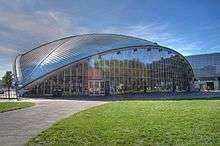
The university historically pioneered research and training collaborations between academia, industry and government.[232][233] In 1946, President Compton, Harvard Business School professor Georges Doriot, and Massachusetts Investor Trust chairman Merrill Grisswold founded American Research and Development Corporation, the first American venture-capital firm.[234][235] In 1948, Compton established the MIT Industrial Liaison Program.[236] Throughout the late 1980s and early 1990s, American politicians and business leaders accused MIT and other universities of contributing to a declining economy by transferring taxpayer-funded research and technology to international – especially Japanese – firms that were competing with struggling American businesses.[237][238] On the other hand, MIT's extensive collaboration with the federal government on research projects has led to several MIT leaders serving as presidential scientific advisers since 1940.[lower-alpha 5] MIT established a Washington Office in 1991 to continue effective lobbying for research funding and national science policy.[240][241]
The US Justice Department began an investigation in 1989, and in 1991 filed an antitrust suit against MIT, the eight Ivy League colleges, and eleven other institutions for allegedly engaging in price-fixing during their annual "Overlap Meetings", which were held to prevent bidding wars over promising prospective students from consuming funds for need-based scholarships.[242][243] While the Ivy League institutions settled,[244] MIT contested the charges, arguing that the practice was not anti-competitive because it ensured the availability of aid for the greatest number of students.[245][246] MIT ultimately prevailed when the Justice Department dropped the case in 1994.[247][248]
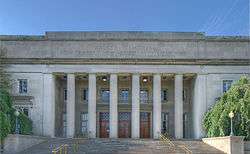
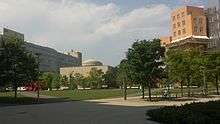
MIT's proximity[lower-alpha 6] to Harvard University ("the other school up the river") has led to a substantial number of research collaborations such as the Harvard-MIT Division of Health Sciences and Technology and the Broad Institute.[249] In addition, students at the two schools can cross-register for credits toward their own school's degrees without any additional fees.[249] A cross-registration program between MIT and Wellesley College has also existed since 1969, and in 2002 the Cambridge–MIT Institute launched an undergraduate exchange program between MIT and the University of Cambridge.[249] MIT also has a long term partnership with Imperial College London, for both student exchanges and research collaboration.[250][251] More modest cross-registration programs have been established with Boston University, Brandeis University, Tufts University, Massachusetts College of Art and the School of the Museum of Fine Arts, Boston.[249]
MIT maintains substantial research and faculty ties with independent research organizations in the Boston area, such as the Charles Stark Draper Laboratory, the Whitehead Institute for Biomedical Research, and the Woods Hole Oceanographic Institution.[209] Ongoing international research and educational collaborations include the Amsterdam Institute for Advanced Metropolitan Solutions (AMS Institute), Singapore-MIT Alliance, MIT-Politecnico di Milano,[249][252] MIT-Zaragoza International Logistics Program, and projects in other countries through the MIT International Science and Technology Initiatives (MISTI) program.[249][253]
The mass-market magazine Technology Review is published by MIT through a subsidiary company, as is a special edition that also serves as an alumni magazine.[254][255] The MIT Press is a major university press, publishing over 200 books and 30 journals annually, emphasizing science and technology as well as arts, architecture, new media, current events and social issues.[256]
Libraries, collections and museums
The MIT library system consists of five subject libraries: Barker (Engineering), Dewey (Economics), Hayden (Humanities and Science), Lewis (Music), and Rotch (Arts and Architecture). There are also various specialized libraries and archives. The libraries contain more than 2.9 million printed volumes, 2.4 million microforms, 49,000 print or electronic journal subscriptions, and 670 reference databases. The past decade has seen a trend of increased focus on digital over print resources in the libraries.[257] Notable collections include the Lewis Music Library with an emphasis on 20th and 21st-century music and electronic music,[258] the List Visual Arts Center's rotating exhibitions of contemporary art,[259] and the Compton Gallery's cross-disciplinary exhibitions.[260] MIT allocates a percentage of the budget for all new construction and renovation to commission and support its extensive public art and outdoor sculpture collection.[261][262]
The MIT Museum was founded in 1971 and collects, preserves, and exhibits artifacts significant to the culture and history of MIT. The museum now engages in significant educational outreach programs for the general public, including the annual Cambridge Science Festival, the first celebration of this kind in the United States. Since 2005, its official mission has been, "to engage the wider community with MIT's science, technology and other areas of scholarship in ways that will best serve the nation and the world in the 21st century".[263]
Research
MIT was elected to the Association of American Universities in 1934 and is classified among "R1: Doctoral Universities – Very high research activity";[51][177] research expenditures totaled $952 million in 2017.[264] The federal government was the largest source of sponsored research, with the Department of Health and Human Services granting $255.9 million, Department of Defense $97.5 million, Department of Energy $65.8 million, National Science Foundation $61.4 million, and NASA $27.4 million.[265] MIT employs approximately 1300 researchers in addition to faculty.[266] In 2011, MIT faculty and researchers disclosed 632 inventions, were issued 153 patents, earned $85.4 million in cash income, and received $69.6 million in royalties.[267] Through programs like the Deshpande Center, MIT faculty leverage their research and discoveries into multi-million-dollar commercial ventures.[268]
In electronics, magnetic core memory, radar, single electron transistors, and inertial guidance controls were invented or substantially developed by MIT researchers.[269][270] Harold Eugene Edgerton was a pioneer in high speed photography and sonar.[271][272] Claude E. Shannon developed much of modern information theory and discovered the application of Boolean logic to digital circuit design theory.[273] In the domain of computer science, MIT faculty and researchers made fundamental contributions to cybernetics, artificial intelligence, computer languages, machine learning, robotics, and cryptography.[270][274] At least nine Turing Award laureates and seven recipients of the Draper Prize in engineering have been or are currently associated with MIT.[275][276]
Current and previous physics faculty have won eight Nobel Prizes,[277] four Dirac Medals,[278] and three Wolf Prizes predominantly for their contributions to subatomic and quantum theory.[279] Members of the chemistry department have been awarded three Nobel Prizes and one Wolf Prize for the discovery of novel syntheses and methods.[277] MIT biologists have been awarded six Nobel Prizes for their contributions to genetics, immunology, oncology, and molecular biology.[277] Professor Eric Lander was one of the principal leaders of the Human Genome Project.[280][281] Positronium atoms,[282] synthetic penicillin,[283] synthetic self-replicating molecules,[284] and the genetic bases for Amyotrophic lateral sclerosis (also known as ALS or Lou Gehrig's disease) and Huntington's disease were first discovered at MIT.[285] Jerome Lettvin transformed the study of cognitive science with his paper "What the frog's eye tells the frog's brain".[286] Researchers developed a system to convert MRI scans into 3D printed physical models.[287]
In the domain of humanities, arts, and social sciences, as of October 2019 MIT economists have been awarded seven Nobel Prizes and nine John Bates Clark Medals.[277][288] Linguists Noam Chomsky and Morris Halle authored seminal texts on generative grammar and phonology.[289][290] The MIT Media Lab, founded in 1985 within the School of Architecture and Planning and known for its unconventional research,[291][292] has been home to influential researchers such as constructivist educator and Logo creator Seymour Papert.[293]
Spanning many of the above fields, MacArthur Fellowships (the so-called "Genius Grants") have been awarded to 50 people associated with MIT.[294] Five Pulitzer Prize–winning writers currently work at or have retired from MIT.[295] Four current or former faculty are members of the American Academy of Arts and Letters.[296]
Allegations of research misconduct or improprieties have received substantial press coverage. Professor David Baltimore, a Nobel Laureate, became embroiled in a misconduct investigation starting in 1986 that led to Congressional hearings in 1991.[297][298] Professor Ted Postol has accused the MIT administration since 2000 of attempting to whitewash potential research misconduct at the Lincoln Lab facility involving a ballistic missile defense test, though a final investigation into the matter has not been completed.[299][300] Associate Professor Luk Van Parijs was dismissed in 2005 following allegations of scientific misconduct and found guilty of the same by the United States Office of Research Integrity in 2009.[301][302]
In 2019, Clarivate Analytics named 54 members of MIT's faculty to its list of "Highly Cited Researchers". That number places MIT 8th among the world's universities.[303]
Discoveries and innovation

Natural sciences
- Oncogene – Robert Weinberg discovered genetic basis of human cancer.[304]
- Reverse transcription – David Baltimore independently isolated, in 1970 at MIT, two RNA tumor viruses: R-MLV and again RSV.[305]
- Thermal death time – Samuel Cate Prescott and William Lyman Underwood from 1895 to 1898. Done for canning of food. Applications later found useful in medical devices, pharmaceuticals, and cosmetics.[306]
Computer and applied sciences
- Akamai Technologies – Daniel Lewin and Tom Leighton discovered and developed a faster content delivery network and is one of the world's largest distributed computing platforms, responsible for serving between 15 and 30 percent of all web traffic.[307]
- Cryptography – MIT researchers Ron Rivest, Adi Shamir and Leonard Adleman developed one of the first practical public-key cryptosystems and started a company RSA (cryptosystem).
- Digital circuits – Claude Shannon, while a master's degree student at MIT, developed the digital circuit design theory which paved the way for modern computers.[308]
- Electronic ink – developed by Joseph Jacobson at MIT Media Lab.[309]
- Emacs (text editor) – development began during the 1970s at the MIT AI Lab.
- Flight recorder (black box) – Charles Stark Draper developed the black box at MIT's Instrumentation Laboratory. That lab later made the Apollo Moon landings possible through the Apollo Guidance Computer it designed for NASA.
- GNU Project – Richard Stallman formally founded the free software movement in 1983 by launching the GNU Project at MIT.[310][311][312]
- Lisp (programming language) – John McCarthy invented lisp in 1958 while he was at MIT. McCarthy published its design in a paper in Communications of the ACM in 1960, entitled "Recursive Functions of Symbolic Expressions and Their Computation by Machine, Part I".[313]
- Lithium-ion battery efficiencies – Yet-Ming Chiang and his group at MIT showed a substantial improvement in the performance of lithium batteries by boosting the material's conductivity by doping it[314] with aluminium, niobium and zirconium.
- MIT OpenCourseWare – the OpenCourseWare movement started in 1999 when the University of Tübingen in Germany published videos of lectures online for its timms initiative (Tübinger Internet Multimedia Server).[315] The OCW movement only took off, however, with the launch of MIT OpenCourseWare and the Open Learning Initiative at Carnegie Mellon University[316] in October 2002. The movement was soon reinforced by the launch of similar projects at Yale, Utah State University, the University of Michigan and the University of California Berkeley.
- Perdix micro-drone – autonomous drone that uses artificial intelligence to swarm with many other Perdix drones.[317]
- Project MAC – groundbreaking research in operating systems, artificial intelligence, and the theory of computation. DARPA funded project.
- Radar – developed at MIT's Radiation Laboratory during World War II.
- SKETCHPAD – invented by Ivan Sutherland at MIT (presented in his PhD thesis). It pioneered the way for human–computer interaction (HCI).[318] Sketchpad is considered to be the ancestor of modern computer-aided design (CAD) programs as well as a major breakthrough in the development of computer graphics in general.
- VisiCalc – first spreadsheet computer program for personal computers, originally released for the Apple II by VisiCorp. MIT alumni Dan Bricklin and Bob Frankston rented time sharing at night on an MIT mainframe computer (that cost $1/hr for use).
- World Wide Web Consortium – founded in 1994 by Tim Berners-Lee, (W3C) is the main international standards organization for the World Wide Web[319]
- X Window System – pioneering architecture-independent system for graphical user interfaces that has been widely used for Unix and Linux systems.
Companies and entrepreneurship
MIT alumni and faculty have founded numerous companies, some of which are shown below:[320][321]
- Analog Devices, 1965, co-founders Ray Stata, (SB, SM) and Matthew Lorber (SB)
- BlackRock, 1988, co-founder Bennett Golub, (SB, SM, PhD)
- Bose Corporation, 1964, founder Amar Bose (SB, PhD)
- Buzzfeed, 2006, co-founder Jonah Peretti (SM)
- Dropbox, 2007, founders Drew Houston (SB) and Arash Ferdowsi (drop-out)
- E*Trade, 1982, co-founder William A. Porter (MBA)
- Hewlett-Packard, 1939, co-founder William R. Hewlett (SM)
- HuffPost, 2005, co-founder Jonah Peretti (SM)
- Intel, 1968, co-founder Robert Noyce (PhD)
- Koch Industries, 1940, founder Fred C. Koch (SB), sons William (SB, PhD), David (SB)
- Qualcomm, 1985, co-founders Irwin M. Jacobs (SM, PhD) and Andrew Viterbi (SB, SM)
- Raytheon, 1922, co-founder Vannevar Bush (DEng, Professor)
- Renaissance Technologies, 1982, founder James Simons (SB)
- Texas Instruments, 1930, founder Cecil Howard Green (SB, SM)
- TSMC, 1987, founder Morris Chang (SB, SM)
- VMware, 1998, co-founder Diane Greene (SM)
- Zipcar, 2000, co-founder Robin Chase (MBA)
Traditions and student activities
The faculty and student body place a high value on meritocracy and on technical proficiency.[322][323] MIT has never awarded an honorary degree, nor does it award athletic scholarships, ad eundem degrees, or Latin honors upon graduation.[324] However, MIT has twice awarded honorary professorships: to Winston Churchill in 1949 and Salman Rushdie in 1993.[325]
Many upperclass students and alumni wear a large, heavy, distinctive class ring known as the "Brass Rat".[326][327] Originally created in 1929, the ring's official name is the "Standard Technology Ring".[328] The undergraduate ring design (a separate graduate student version exists as well) varies slightly from year to year to reflect the unique character of the MIT experience for that class, but always features a three-piece design, with the MIT seal and the class year each appearing on a separate face, flanking a large rectangular bezel bearing an image of a beaver.[326] The initialism IHTFP, representing the informal school motto "I Hate This Fucking Place" and jocularly euphemized as "I Have Truly Found Paradise", "Institute Has The Finest Professors", "Institute of Hacks, Tomfoolery and Pranks", "It's Hard to Fondle Penguins", and other variations, has occasionally been featured on the ring given its historical prominence in student culture.[329]
Activities
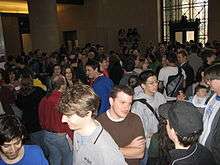
MIT has over 500 recognized student activity groups,[330] including a campus radio station, The Tech student newspaper, an annual entrepreneurship competition, and weekly screenings of popular films by the Lecture Series Committee. Less traditional activities include the "world's largest open-shelf collection of science fiction" in English, a model railroad club, and a vibrant folk dance scene. Students, faculty, and staff are involved in over 50 educational outreach and public service programs through the MIT Museum, Edgerton Center, and MIT Public Service Center.[331]
Fraternities and sororities provide a base of activities in addition to housing. Approximately 1,000 undergrads, 48% of men and 30% of women, participate in one of several dozen Greek Life men's, women's and co-ed chapters on the campus.[332]
The Independent Activities Period is a four-week-long "term" offering hundreds of optional classes, lectures, demonstrations, and other activities throughout the month of January between the Fall and Spring semesters. Some of the most popular recurring IAP activities are Autonomous Robot Design (course 6.270), Robocraft Programming (6.370), and MasLab competitions,[333] the annual "mystery hunt",[334] and Charm School.[335][336] More than 250 students pursue externships annually at companies in the US and abroad.[337][338]
Many MIT students also engage in "hacking", which encompasses both the physical exploration of areas that are generally off-limits (such as rooftops and steam tunnels), as well as elaborate practical jokes.[339][340] Recent high-profile hacks have included the abduction of Caltech's cannon,[341] reconstructing a Wright Flyer atop the Great Dome,[342] and adorning the John Harvard statue with the Master Chief's Mjölnir Helmet.[343]
Athletics
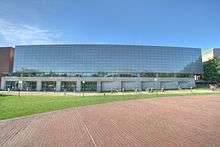
MIT sponsors 31 varsity sports and has one of the three broadest NCAA Division III athletic programs.[344][345] MIT participates in the NCAA's Division III, the New England Women's and Men's Athletic Conference, the New England Football Conference, NCAA's Division I Patriot League for women's crew, and the Collegiate Water Polo Association (CWPA) for Men's Water Polo. Men's crew competes outside the NCAA in the Eastern Association of Rowing Colleges (EARC). The intercollegiate sports teams, called the MIT Engineers won 22 Team National Championships, 42 Individual National Championships. MIT is the all-time Division III leader in producing Academic All-Americas (302) and rank second across all NCAA Divisions only behind the University of Nebraska.[346] MIT Athletes won 13 Elite 90 awards and ranks first among NCAA Division III programs, and third among all divisions.[347] In April 2009, budget cuts led to MIT eliminating eight of its 41 sports, including the mixed men's and women's teams in alpine skiing and pistol; separate teams for men and women in ice hockey and gymnastics; and men's programs in golf and wrestling.[348][349]
People
Students
| Undergraduate | Graduate | |
|---|---|---|
| White American | 34% | 40.8% |
| Asian American | 30% | 9.4% |
| Hispanic American | 15% | 3.3% |
| African American | 10% | 2.1% |
| Native American | 1.0% | 0.4% |
| Other/International | 8% | 44.0% |
MIT enrolled 4,602 undergraduates and 6,972 graduate students in 2018–2019.[352] Women constituted 45 percent of undergraduate students.[183][353] Undergraduate and graduate students came from all 50 US states as well as from 115 foreign countries.[354]
MIT received 20,075 applications for admission to the undergraduate Class of 2024: it admitted 1,457 (7.2 percent).[355] In 2019, 29,114 applications were received for graduate and advanced degree programs across all departments; 3,670 were admitted (12.6 percent) and 2,312 enrolled (63 percent).[356]
The interquartile range on the SAT was 2090–2340 and 97 percent of students ranked in the top tenth of their high school graduating class.[154] 97 percent of the Class of 2012 returned as sophomores; 82 percent of the Class of 2007 graduated within 4 years, and 93 percent (91 percent of the men and 95 percent of the women) graduated within 6 years.[154][357]
Undergraduate tuition and fees total $40,732 per student and annual expenses are estimated at $52,507 as of 2012. 62 percent of students received need-based financial aid in the form of scholarships and grants from federal, state, institutional, and external sources averaging $38,964 per student.[358] Students were awarded a total of $102 million in scholarships and grants, primarily from institutional support ($84 million).[154] The annual increase in expenses has led to a student tradition (dating back to the 1960s) of tongue-in-cheek "tuition riots".[359]
MIT has been nominally co-educational since admitting Ellen Swallow Richards in 1870. Richards also became the first female member of MIT's faculty, specializing in sanitary chemistry.[360][361] Female students remained a small minority prior to the completion of the first wing of a women's dormitory, McCormick Hall, in 1963.[362][363][364] Between 1993 and 2009 the proportion of women rose from 34 percent to 45 percent of undergraduates and from 20 percent to 31 percent of graduate students.[183][365] As of 2009, women outnumbered men in Biology, Brain & Cognitive Sciences, Architecture, Urban Planning, and Biological Engineering.[183][353]
A number of student deaths in the late 1990s and early 2000s resulted in considerable media attention focussing on MIT's culture and student life.[366][367] After the alcohol-related death of Scott Krueger in September 1997 as a new member at the Phi Gamma Delta fraternity,[368] MIT began requiring all freshmen to live in the dormitory system.[368][369] The 2000 suicide of MIT undergraduate Elizabeth Shin drew attention to suicides at MIT and created a controversy over whether MIT had an unusually high suicide rate.[370][371] In late 2001 a task force's recommended improvements in student mental health services were implemented,[372][373] including expanding staff and operating hours at the mental health center.[374] These and later cases were significant as well because they sought to prove the negligence and liability of university administrators in loco parentis.[370]
Faculty and staff
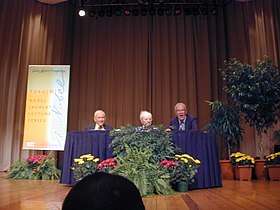
As of 2013, MIT had 1,030 faculty members.[4] Faculty are responsible for lecturing classes, for advising both graduate and undergraduate students, and for sitting on academic committees, as well as for conducting original research. Between 1964 and 2009 a total of seventeen faculty and staff members affiliated with MIT won Nobel Prizes (thirteen of them in the latter 25 years).[375] As of October 2019, 37 MIT faculty members, past or present, have won Nobel Prizes, the majority in Economics or Physics.[376]
As of October 2013, current faculty and teaching staff included 67 Guggenheim Fellows, 6 Fulbright Scholars, and 22 MacArthur Fellows.[4] Faculty members who have made extraordinary contributions to their research field as well as the MIT community are granted appointments as Institute Professors for the remainder of their tenures.
A 1998 MIT study concluded that a systemic bias against female faculty existed in its School of Science,[377] although the study's methods were controversial.[378][379] Since the study, though, women have headed departments within the Schools of Science and of Engineering, and MIT has appointed several female vice-presidents, although allegations of sexism continue.[380] Susan Hockfield, a molecular neurobiologist, served as MIT's president from 2004 to 2012 – the first woman to hold the post.[176]
Tenure issues have vaulted MIT into the national spotlight on several occasions. The 1984 dismissal of David F. Noble (a historian of technology) became a cause célèbre about the extent to which academics are granted freedom of speech after he published several books and papers critical of MIT's and other research universities' reliance upon financial support from corporations and the military.[381] Former materials-science professor Gretchen Kalonji sued MIT in 1994, alleging that she was denied tenure because of sexual discrimination. Several years later, the lawsuit was settled with undisclosed payments and the establishment of a project to encourage women and minorities to seek faculty positions.[380][382][383] In 1997 the Massachusetts Commission Against Discrimination issued a probable-cause finding supporting UMass Boston Professor James Jennings' allegations of racial discrimination after a senior faculty search committee in the Department of Urban Studies and Planning did not offer him reciprocal tenure.[384]
In 2006–2007, MIT's denial of tenure to African-American stem-cell scientist professor James Sherley reignited accusations of racism in the tenure process, eventually leading to a protracted public dispute with the administration, a brief hunger-strike, and the resignation of Professor Frank L. Douglas in protest.[385][386] The Boston Globe reported on February 6, 2007: "Less than half of MIT's junior faculty members are granted tenure. After Sherley was initially denied tenure, his case was examined three times before the university established that neither racial discrimination nor conflict of interest affected the decision. Twenty-one of Sherley's colleagues later issued a statement saying that the professor was treated fairly in tenure review."[387]
MIT faculty members have often been recruited to lead other colleges and universities. Founding faculty-member Charles W. Eliot became president of Harvard University in 1869, a post he would hold for 40 years, during which he wielded considerable influence both on American higher education and on secondary education. MIT alumnus and faculty member George Ellery Hale played a central role in the development of the California Institute of Technology (Caltech), and other faculty members have been key founders of Franklin W. Olin College of Engineering in nearby Needham, Massachusetts.
As of 2014 former provost Robert A. Brown served as president of Boston University; former provost Mark Wrighton is chancellor of Washington University in St. Louis; former associate provost Alice Gast is president of Lehigh University; and former professor Suh Nam-pyo is president of KAIST. Former dean of the School of Science Robert J. Birgeneau was the chancellor of the University of California, Berkeley (2004–2013); former professor John Maeda was president of Rhode Island School of Design (RISD, 2008–2013); former professor David Baltimore was president of Caltech (1997–2006); and MIT alumnus and former assistant professor Hans Mark served as chancellor of the University of Texas system (1984–1992).
In addition, faculty members have been recruited to lead governmental agencies; for example, former professor Marcia McNutt is president of the National Academy of Sciences,[388] urban studies professor Xavier de Souza Briggs served as the associate director of the White House Office of Management and Budget,[389] and biology professor Eric Lander was a co-chair of the President's Council of Advisors on Science and Technology.[390] In 2013, faculty member Ernest Moniz was nominated by President Obama and later confirmed as United States Secretary of Energy.[391][392] Former professor Hans Mark served as Secretary of the Air Force from 1979 to 1981. Alumna and Institute Professor Sheila Widnall served as Secretary of the Air Force between 1993 and 1997, making her the first female Secretary of the Air Force and first woman to lead an entire branch of the US military in the Department of Defense.
As of 2017, MIT was the second-largest employer in the city of Cambridge.[134] Based on feedback from employees, MIT was ranked #7 as a place to work, among US colleges and universities as of March 2013.[393] Surveys cited a "smart", "creative", "friendly" environment, noting that the work-life balance tilts towards a "strong work ethic" but complaining about "low pay" compared to an industry position.[394]
Notable alumni
Many of MIT's over 120,000 alumni have had considerable success in scientific research, public service, education, and business. As of October 2019, 39 MIT alumni have won the Nobel Prize, 47 have been selected as Rhodes Scholars, and 61 have been selected as Marshall Scholars.[395]
Alumni in American politics and public service include former Chairman of the Federal Reserve Ben Bernanke, former MA-1 Representative John Olver, former CA-13 Representative Pete Stark, Representative Thomas Massie, former National Economic Council chairman Lawrence H. Summers, and former Council of Economic Advisors chairman Christina Romer. MIT alumni in international politics include Foreign Affairs Minister of Iran Ali Akbar Salehi, Israeli Prime Minister Benjamin Netanyahu, President of Colombia Virgilio Barco Vargas, President of the European Central Bank Mario Draghi, former Governor of the Reserve Bank of India Raghuram Rajan, former British Foreign Minister David Miliband, former Greek Prime Minister Lucas Papademos, former UN Secretary General Kofi Annan, former Iraqi Deputy Prime Minister Ahmed Chalabi, former Minister of Education and Culture of The Republic of Indonesia Yahya Muhaimin, former Jordanian Minister of Education, Higher Education and Scientific Research & former Jordanian Minister of Energy and Mineral Resources Khaled Toukan. Alumni in sports have included Olympic fencing champion Johan Harmenberg.
MIT alumni founded or co-founded many notable companies, such as Intel, McDonnell Douglas, Texas Instruments, 3Com, Qualcomm, Bose, Raytheon, Apotex, Koch Industries, Rockwell International, Genentech, Dropbox, and Campbell Soup. According to the British newspaper, The Guardian, "a survey of living MIT alumni found that they have formed 25,800 companies, employing more than three million people including about a quarter of the workforce of Silicon Valley. Those firms collectively generate global revenues of about $1.9 trillion (£1.2 trillion) a year". If the companies founded by MIT alumni were a country, they would have the 11th highest GDP of any nation in the world.[396][397][398]
Prominent institutions of higher education have been led by MIT alumni, including the University of California system, Harvard University, New York Institute of Technology, Johns Hopkins University, Carnegie Mellon University, Tufts University, Rochester Institute of Technology, Rhode Island School of Design (RISD), New Jersey Institute of Technology, Northeastern University, Tel Aviv University, Lahore University of Management Sciences, Rensselaer Polytechnic Institute, Tecnológico de Monterrey, Purdue University, Virginia Polytechnic Institute, KAIST, and Quaid-e-Azam University. Berklee College of Music, the largest independent college of contemporary music in the world, was founded and led by MIT alumnus Lawrence Berk for more than three decades.
More than one third of the United States' manned spaceflights have included MIT-educated astronauts, more than any university excluding the United States service academies.[399] Of the 12 people who have been on the Moon as of 2019, four graduated from MIT (among them Apollo 11 Lunar Module Pilot Buzz Aldrin). Alumnus and former faculty member Qian Xuesen led the Chinese nuclear weapons program and was instrumental in the PRC rocket program.[400]
Noted alumni in non-scientific fields include author Hugh Lofting,[401] sculptor Daniel Chester French, guitarist Tom Scholz of the band Boston, the British BBC and ITN correspondent and political advisor David Walter, The New York Times columnist and Nobel Prize Winning economist Paul Krugman, The Bell Curve author Charles Murray, United States Supreme Court building architect Cass Gilbert,[402] Pritzker Prize-winning architects I.M. Pei and Gordon Bunshaft.
 Apollo 11 astronaut Buzz Aldrin, ScD 1963 (Aero and Astro)
Apollo 11 astronaut Buzz Aldrin, ScD 1963 (Aero and Astro)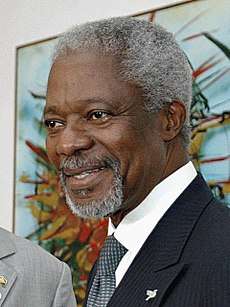 Former UN Secretary-General Kofi Annan, SM 1972 (Management)
Former UN Secretary-General Kofi Annan, SM 1972 (Management)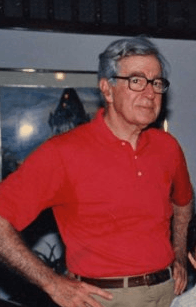 President of Colombia 1986–1990 Virgilio Barco Vargas, SB 1943 (Civil Engineering)
President of Colombia 1986–1990 Virgilio Barco Vargas, SB 1943 (Civil Engineering)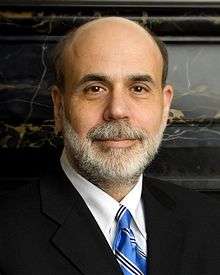 Former Federal Reserve Bank chairman Ben Bernanke, PhD 1979 (Economics)
Former Federal Reserve Bank chairman Ben Bernanke, PhD 1979 (Economics)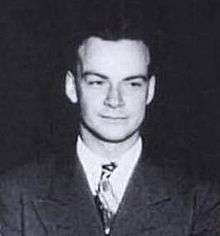 Physicist Nobel laureate Richard Feynman, SB 1939 (Physics)
Physicist Nobel laureate Richard Feynman, SB 1939 (Physics)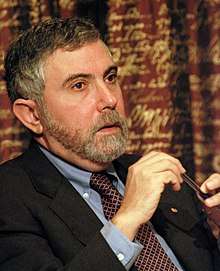 Economics Nobel laureate Paul Krugman, PhD 1977 (Economics)
Economics Nobel laureate Paul Krugman, PhD 1977 (Economics)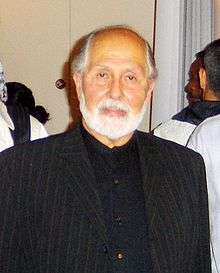 Muslim philosopher/author Seyyed Hossein Nasr, SB 1954 (Physics)
Muslim philosopher/author Seyyed Hossein Nasr, SB 1954 (Physics)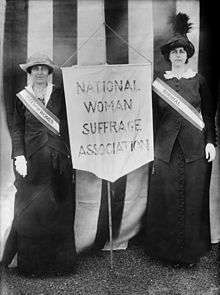 Biologist, suffragist, philanthropist Katherine Dexter McCormick (left), SB 1904 (Biology)
Biologist, suffragist, philanthropist Katherine Dexter McCormick (left), SB 1904 (Biology)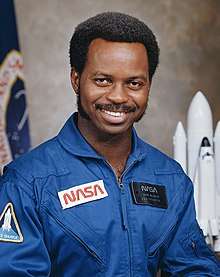 Space Shuttle Challenger astronaut and physicist Ronald McNair, PhD 1976 (Physics)
Space Shuttle Challenger astronaut and physicist Ronald McNair, PhD 1976 (Physics)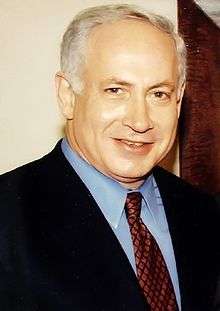 Israeli Prime Minister Benjamin Netanyahu, SB 1975 (Architecture), SM 1976 (Management)
Israeli Prime Minister Benjamin Netanyahu, SB 1975 (Architecture), SM 1976 (Management)- Architect I. M. Pei, BArch 1940 (Architecture)
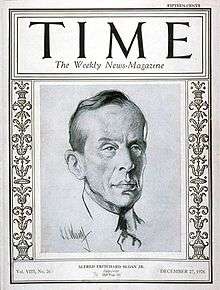 CEO of General Motors Alfred P. Sloan, SB 1895 (Electrical Engineering)
CEO of General Motors Alfred P. Sloan, SB 1895 (Electrical Engineering)- "Boston" guitarist Tom Scholz, SB 1969, SM 1970 (Mechanical Engineering)
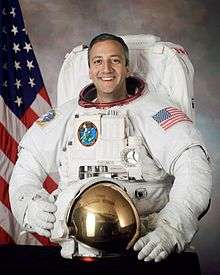 Mike Massimino (Astronaut and Engineer)
Mike Massimino (Astronaut and Engineer)
See also
- The Coop, campus bookstore
- Engineering
- Glossary of engineering
Notes
- The friezes of the marble-clad buildings surrounding Killian Court are carved in large Roman letters with the names of Aristotle, Newton, Pasteur, Lavoisier, Faraday, Archimedes, da Vinci, Darwin, and Copernicus; each of these names is surmounted by a cluster of appropriately related names in smaller letters. Lavoisier, for example, is placed in the company of Boyle, Cavendish, Priestley, Dalton, Gay Lussac, Berzelius, Woehler, Liebig, Bunsen, Mendelejeff [sic], Perkin, and van't Hoff.[140][141]
- The Harvard-MIT Division of Health Sciences and Technology (HST) offers joint MD, MD-PhD, or Medical Engineering degrees in collaboration with Harvard Medical School.[171]
- Course numbers are sometimes presented in Roman numerals, e.g. "Course XVIII" for mathematics.[183] At least one MIT style guide now discourages this usage.[184] Also, some Course numbers have been re-assigned over time, so that the subject area of a degree may depend on the year it was awarded.[181]
- Figure includes 196 students working on Harvard degrees only.
- Vannevar Bush was the director of the Office of Scientific Research and Development and general advisor to Franklin D. Roosevelt and Harry Truman, James Rhyne Killian was Special Assistant for Science and Technology for Dwight D. Eisenhower, and Jerome Wiesner advised John F. Kennedy and Lyndon Johnson.[239]
- MIT's Building 7 and Harvard's Johnston Gate, the traditional entrances to each school, are 1.72 miles (2.77 km) apart along Massachusetts Avenue.
References
- "Symbols: Seal". MIT Graphic Identity. MIT. Retrieved 2010-09-08.
- "NAICU – Membership". Archived from the original on 2015-11-09.
- As of June 30, 2019. "U.S. and Canadian 2019 NTSE Participating Institutions Listed by Fiscal Year 2019 Endowment Market Value, and Percentage Change in Market Value from FY18 to FY19 (Revised)". National Association of College and University Business Officers and TIAA. Retrieved 2020-04-22.
- "Faculty and Staff". MIT Facts. MIT. Retrieved 2014-03-11.
- "Enrollment Statistics by Year". MIT Registrar's Office. Retrieved 2020-02-06.
- "The Campus". MIT Facts 2018. Retrieved 2018-11-11.
- "Top Ten MIT History Facts". Libraries.MIT.edu. Retrieved 2017-08-09.
- "Colors–MIT Graphic Identity". Web.MIT.edu. Retrieved 2018-06-05.
- "History of Tim". TimBeaver100.MIT.edu. Retrieved 2020-04-14.
- "World's 10 most prestigious universities 2016". THE World University Rankings. Times Higher Education. 2016-05-04.
- Smith, Matthew (May 2016). "The 24 most prestigious universities in the world, according to Times Higher Education". Business Insider.
- Denham, Jess (2013-09-10). "So why is MIT number one in the world university rankings?". Independent.
- David Altaner (2011-03-09). "Harvard, MIT Ranked Most Prestigious Universities, Study Reports". Bloomberg. Retrieved 2012-03-01.
- "Notable Awards | MIT CSAIL". www.csail.mit.edu. Retrieved 2019-10-18.
- "MIT Facts 2018: Faculty and Staff". web.mit.edu. Retrieved 2019-03-07.
- "Statistics". www.marshallscholarship.org. Retrieved 2019-03-08.
- "Rhodes Scholarships: Number of Winners by Institution, U.S. Rhodes Scholars (1904 ‐ 2019)" (PDF). The Rhodes Trust.
- "NASA Chooses Three MIT Alumni to be Astronauts". alum.mit.edu. Retrieved 2019-03-07.
- "MIT Facts 2018: Entrepreneurship and Innovation". web.mit.edu. Retrieved 2018-04-15.
- "Entrepreneurship and Innovation at MIT (December 2015)" (PDF). MIT.
- "Massachusetts Institute of Technology | Association of American Universities". www.aau.edu. Retrieved 2018-08-17.
- Kneeland, Samuel (March 1859). "Committee Report: Conservatory of Art and Science" (PDF). Massachusetts House of Representatives, House No. 260. Archived from the original (PDF) on 2010-06-12. Retrieved 2008-06-07.
- "MIT Timeline". MIT History. MIT Institute Archives. Archived from the original on 2013-02-19. Retrieved 2015-04-01.
- "Acts and Resolves of the General Court Relating to the Massachusetts Institute of Technology" (PDF). MIT History. MIT Institute Archives. Archived from the original (PDF) on 2015-07-01. Retrieved 2012-05-29.
- "MIT Facts 2012: Origins and Leadership". MIT Facts. MIT. Retrieved 2012-05-29.
- Rogers, William (1861). "Objects and Plan of an Institute of Technology: including a Society of Arts, a Museum of Arts, and a School of Industrial Science; proposed to be established in Boston" (PDF). The Committee of Associated Institutions of Science and Arts. Archived from the original (PDF) on 2010-06-12. Retrieved 2008-06-07.
- Lewis 1949, p. 8.
- "Letter from William Barton Rogers to His Brother Henry". Institute Archives, MIT. 1846-03-13. Archived from the original on 2016-03-04. Retrieved 2010-10-02.
- Angulo, A.J. (2009-01-26). William Barton Rogers and the Idea of MIT. The Johns Hopkins University Press. pp. 155–156. ISBN 978-0-8018-9033-8.
- Angulo, A.J. "The Initial Reception of MIT, 1860s–1880s". In Geiger, Roger L. (ed.). Perspectives on the History of Higher Education. pp. 1–28.
- Andrews, Elizabeth; Murphy, Nora; Rosko, Tom (2000). "William Barton Rogers: MIT's Visionary Founder". MIT. Archived from the original on 2008-05-12. Retrieved 2006-03-08.
- Stratton, Julius Adams; Mannix, Loretta H. (2005). "The Land-Grant Act of 1862". Mind and Hand: The Birth of MIT. MIT Press. pp. 251–276. ISBN 0-262-19524-0.
- "Morrill Act:Primary Documents of American History". Library of Congress. 2016. Retrieved 2016-02-10.
- Prescott, Samuel C (1954). When MIT Was "Boston Tech", 1861–1916. MIT Press.
- Dunbar, Charles F. (July 1897). "The Career of Francis Amasa Walker". Quarterly Journal of Economics. 11 (4): 446–447. doi:10.2307/1880719. JSTOR 1880719.CS1 maint: ref=harv (link)
- "Explore campus, visit Boston, and find out if MIT fits you to a tea". 2006-12-16. Retrieved 2006-12-16.
- Munroe, James P. (1923). A Life of Francis Amasa Walker. New York: Henry Holt & Company. pp. 233, 382.
- Lewis 1949, p. 12.
- "Alumni Petition Opposing MIT-Harvard Merger, 1904–05". Institute Archives, MIT. Archived from the original on 2010-07-22. Retrieved 2010-10-01.
- Alexander, Philip N. "MIT-Harvard Rivalry Timeline". MIT Music and Theater Arts News. Massachusetts Institute of Technology. Retrieved 2014-07-07.
- "MIT150 Exhibition Nomination". museum.mit.edu.
- "MIT Museum". webmuseum.mit.edu.
- "Souvenir Program, Dedication of Cambridge Campus, 1916". Object of the Month. MIT Institute Archives & Special Collections. Archived from the original on 2012-05-10. Retrieved 2012-05-29.
- Middlesex Canal (Massachusetts) map, 1852 (Map). J. B. Shields. 1852. Retrieved 2010-09-17.
- "Freeman's 1912 Design for the "New Technology"". Object of the Month. MIT Institute Archives & Special Collections. Archived from the original on 2012-05-27. Retrieved 2012-05-29.
- Lindsay, David (2000). "Eastman Becomes a Mystery Donor to MIT". PBS-WGBH.
- Lokhova, Sventlana (October 2019). The Spy Who Changed History. ISBN 978-1643132143.
- Lecuyer, Christophe (1992). "The making of a science based technological university: Karl Compton, James Killian, and the reform of MIT, 1930–1957". Historical Studies in the Physical and Biological Sciences. 23 (1): 153–180. doi:10.2307/27757693. JSTOR 27757693.
- Lewis 1949, p. 13.
- Geiger, Roger L. (2004). To advance knowledge: the growth of American research universities, 1900–1940. pp. 13–15, 179–9. ISBN 0-19-503803-7.
- "Member Institutions and Years of Admission". Association of American Universities. Archived from the original on 2012-10-28. Retrieved 2012-06-26.
- Lewis 1949, p. 113.
- Bourzac, Katherine, "Rethinking an MIT Education: The faculty reconsiders the General Institute Requirements", Technology Review, Monday, March 12, 2007
- "History: School of Humanities, Arts, and Social Sciences". MIT Archives. Archived from the original on 2010-03-11. Retrieved 2008-07-25.
- "History: Sloan School of Management". MIT Archives. Archived from the original on 2010-06-21. Retrieved 2008-07-25.
- Johnson, Howard Wesley (2001). Holding the Center: Memoirs of a Life in Higher Education. MIT Press. ISBN 0-262-60044-7.
- Zachary, Gregg (1997). Endless Frontier: Vannevar Bush, Engineer of the American Century. Free Press. pp. 248–249. ISBN 0-684-82821-9.
- "MIT's Rad Lab". IEEE Global History Network. Retrieved 2008-07-25.
- "Doc Draper & His Lab". History. The Charles Stark Draper Laboratory, Inc. Archived from the original on 2012-05-27. Retrieved 2012-05-30.
- "Charles Draper: Gyroscopic Apparatus". Inventor of the Week. MIT School of Engineering. Archived from the original on 2012-04-18. Retrieved 2012-05-30.
- "Project Whirlwind". Object of the Month. MIT Institute Archives & Special Collections. Archived from the original on 2012-05-30. Retrieved 2012-05-30.
- "Wartime Strobe: 1939–1945 – Harold "Doc" Edgerton (Doc's Life)". Retrieved 2009-11-28.
- Bedi, Joyce (May 2010). "MIT and World War II: Ingredients for a Hot Spot of Invention" (PDF). Prototype. Archived from the original (PDF) on 2012-05-24. Retrieved 2012-05-30.
- Leslie, Stuart (1993). The Cold War and American Science: The Military-Industrial-Academic Complex at MIT and Stanford. Columbia University Press. ISBN 0-231-07959-1.
- Lewis 1949, p. 49.
- Lecuyer, 1992
- Todd, Richard (1969-05-18). "The 'Ins' and 'Outs' at MIT". The New York Times.
- <Please add first missing authors to populate metadata.> (1969-02-28). "A Policy of Protest". Time. Retrieved 2008-08-13.
- MIT Review Panel on Special Laboratories Final Report; S.Leslie, The Cold War and American Science. The military-industrial complex at MITand Stanford; M.Albert, Remembering Tomorrow, pp. 97–99; 'MIT may be dangerous to the world', The Tech, 28/4/72, p. 5; 'Why Smash MIT?' in I.Wallerstein, University Crisis Reader, vol. 2, pp. 240–3; The Technology Review, December 1969.
- "Founding Document: 1968 MIT Faculty Statement". Union of Concerned Scientists, USA. Archived from the original on 2008-01-15. Retrieved 2008-08-12.
- Hechinger, Fred (1969-11-09). "Tension Over Issue of Defense Research". The New York Times.
- Stevens, William (1969-05-05). "MIT Curb on Secret Projects Reflects Growing Antimilitary Feeling Among Universities' Researchers". The New York Times.
- Warsh, David (1999-06-01). "A tribute to MIT's Howard Johnson". The Boston Globe. Retrieved 2007-04-04.
At a critical time in the late 1960s, Johnson stood up to the forces of campus rebellion at MIT. Many university presidents were destroyed by the troubles. Only Edward Levi, University of Chicago president, had comparable success guiding his institution to a position of greater strength and unity after the turmoil.
- 'Battering Ram: The occupation of the president's office', The Tech, 14/12/71 p. 4 and The Tech, 4/8/72; M.Albert, Remembering Tomorrow pp. 9, 97–99; 'Michael Albert interview', 17/4/07; G.Katsiaficas, 'Review of Howard Johnson's Holding the Center; S.Shalom, 'A flawed political biography' Archived August 8, 2016, at the Wayback Machine, New Politics, Issue 23.
- November Actions youtube extract'. See also: MIT Museum photos of student activism, 1960s/1970s.
- The Tech, May 27, 1988, pp. 2, 11 and February 24, 1989, p. 5 and March 7, 1989, 2, 16; The Thistle, Vol. 9 No. 7; Science for the People, Vol. 20 January/February 1988, pp. 17–25, 41–2 and March/April 1988, p. 6.
- MIT News, ‘MIT cheetah robot lands the running jump’ (2015) and ‘Driving drones can be a drag’ (2012); ‘Department of Defense Announces Successful Micro-Drone Demonstration’ (2017); MIT Technology Review, March 20, 2002.
- Lee, J.A.N.; McCarthy, J.; Licklider, J.C.R. (1992). "The beginnings at MIT". IEEE Annals of the History of Computing. 14 (1): 18–54. doi:10.1109/85.145317.
- "Internet History". Computer History Museum. Retrieved 2008-08-13.
- Raymond, Eric S. "A Brief History of Hackerdom". Retrieved 2008-08-11.
- "The Media Lab – Retrospective". MIT Media Lab. Archived from the original on 2009-04-17. Retrieved 2008-08-12.
- "About W3C: History". World Wide Web Consortium. Retrieved 2008-08-11.
- "MIT OpenCourseWare". MIT. Retrieved 2008-06-12.
- "Mission – One Laptop Per Child". One Laptop Per Child. Retrieved 2008-08-11.
- "Massachusetts Space Grant Consortium". Massachusetts Space Grant Consortium. Retrieved 2008-08-26.
- "MIT Sea Grant College Program". MIT Sea Grant College Program. Archived from the original on 2009-04-04. Retrieved 2008-08-26.
- Simha., O. R. (2003). MIT campus planning 1960–2000: An annotated chronology. MIT Press. pp. 120–149. ISBN 978-0-262-69294-6.
- "MIT Facilities: In Development & Construction". MIT. Archived from the original on 2009-03-12. Retrieved 2008-07-22.
- Bombardieri, Marcella (2006-09-14). "MIT will accelerate its building boom: $750m expansion to add 4 facilities". The Boston Globe. Retrieved 2008-08-13.
- "About MITEI". MIT Energy Initiative. Retrieved 2012-05-31.
- Attwood, Rebecca (2009-09-24). "Get it out in the open". Times Higher Education.
- Goldberg, Carey (2001-04-04). "Auditing Classes at M.I.T., on the Web and Free". The New York Times.
- Hafner, Katie (2010-04-16). "An Open Mind". The New York Times.
- Guttenplan, D.D. (2010-11-01). "For Exposure, Universities Put Courses on the Web". The New York Times.
- Lewin, Tamar (2011-12-19). "M.I.T. Expands Its Free Online Courses". The New York Times.
- "What is edX?". MIT News Office. 2012-05-02.
- "Massachusetts Institute of Technology". ROARMAP: Registry of Open Access Repository Mandates and Policies. UK: University of Southampton. 2014-12-15. Retrieved 2018-07-24.
- Ruderman, Wendy; Kovaleski, Serge; Cooper, Michael (2013-04-24). "Officer's Killing Spurred Pursuit in Boston Attack". The New York Times.
- Bidgood, Jess (2013-04-24). "On a Field at M.I.T., 10,000 Remember an Officer Who Was Killed". New York Times. Retrieved 2014-01-30.
- Faviero, Bruno B. F. (2013-04-26). "Thousands attend Sean Collier memorial service". The Tech. 133 (21). Retrieved 2014-01-30.
- "Thousands attend slain MIT officer's memorial service". CBS News. 2013-04-24.
- "Letter regarding the establishment of the Collier Medal". MIT News. 2013-11-25. Retrieved 2013-11-26.
- "Collier Medal". MIT Police. MIT. Retrieved 2013-11-26.
- Rocheleau, Matt (2013-11-26). "MIT to establish a Sean Collier award". The Boston Globe. Retrieved 2013-11-26.
- "IBM and MIT partner on artificial intelligence research". ABC News. Associated Press. September 7, 2017. Archived from the original on September 7, 2017. Retrieved September 7, 2017.
- Gershgorn, Dave (2018-10-15). "MIT is building a billion-dollar college dedicated to AI". Quartz. Retrieved 2018-10-16.
- "Jeffrey Epstein's foundations gave nearly $800K to MIT". 2019-08-23.
- "My apology regarding Jeffrey Epstein".
- "I am writing to apologize to Jeffrey Epstein's victims". 2019-08-24.
- Graham, Eleanor. "Seth Lloyd should not be teaching at MIT". The Tech. Retrieved 2019-11-10.
- Tracy, Marc; Hsu, Tiffany (2019-09-07). "Director of M.I.T.'s Media Lab Resigns After Taking Money From Jeffrey Epstein". The New York Times. ISSN 0362-4331. Retrieved 2019-11-10.
- Durant, Elizabeth. "Smoot's Legacy: 50th anniversary of famous feat nears". Technology Review. Retrieved 2008-08-13.
- Fahrenthold, David (2005-12-08). "The Measure of This Man Is in the Smoot; MIT's Human Yardstick Honored for Work". The Washington Post.
- "Cambridge: Just the Facts (City Facts Brochure)". City of Cambridge. Retrieved 2012-05-31.
- "MIT Course Catalogue: Overview". MIT. Retrieved 2008-07-16.
- "MIT presents updated Kendall Square Initiative plan to City of Cambridge". MIT News. Retrieved 2016-01-23.
- "Kendall Square Initiative". kendallsquare.mit.edu. MIT. Retrieved 2016-04-06.
- "Letter to the community on East Campus/Kendall Square design firm selection". MIT News. MIT. 2014-09-23. Retrieved 2016-04-06.
- "Building History and Numbering System". Mind and Hand Book, MIT. Archived from the original on 2010-12-22. Retrieved 2008-08-13.
- "MIT Campus Subterranean Map" (PDF). MIT Department of Facilities. Archived from the original (PDF) on 2010-07-31. Retrieved 2008-08-13.
- Abel, David (2000-03-30). "'Hackers' Skirt Security in Late-Night MIT Treks". The Boston Globe.
- "MIT Course Catalogue". MIT. Archived from the original on 2009-01-04. Retrieved 2008-07-14.
- "Loose Nukes: A Special Report". ABC News. Retrieved 2007-04-14.
- "MIT Assures Community of Research Reactor Safety". MIT News Office. 2005-10-13. Retrieved 2006-10-05.
- Chun, Matthew G.H. (1999-04-14). "Bill Gates Donates $20 million to MIT". The Harvard Crimson. The Harvard Crimson, Inc. Retrieved 2014-04-06.
- "Research Capabilities | MIT.nano". mitnano.mit.edu.
- Chandler, David (2018-09-23). "A big new home for the ultrasmall". MIT News.
- "Supersonic Tunnel Open; Naval Laboratory for Aircraft Dedicated at M.I.T.". The New York Times. 1949-12-02.
- "Ship Test Tank for M.I.T.; Dr. Killian Announces Plant to Cost $500,000". The New York Times. 1949-02-06.
- "MIT maps wireless users across campus". MIT. 2005-11-04. Archived from the original on 2006-09-05. Retrieved 2007-03-03.
- "Notice of Lodging of Consent Decree Pursuant to the Resource Conservation and Recovery Act, the Clean Air Act, and the Clean Water Act". Environmental Protection Agency. 2001-05-03. Archived from the original on 2008-12-25. Retrieved 2008-07-16.
- Sales, Robert (2001-04-21). "MIT to create three new environmental projects as part of agreement with EPA". MIT News Office. Retrieved 2008-07-16.
- "The Environment at MIT: Conservation". MIT. Archived from the original on 2009-01-04. Retrieved 2008-08-11.
- "MIT Facts 2017: MIT and the Community". web.mit.edu. Retrieved 2017-03-24.
- "Institutional Ownership Map – Cambridge Massachusetts" (PDF).
- "MIT Architecture: Welcome". MIT Department of Architecture. Archived from the original on 2007-03-23. Retrieved 2007-04-04.
- Dillon, David (2004-02-22). "Starchitecture on Campus". The Boston Globe. Retrieved 2006-10-24.
- Flint, Anthony (2002-10-13). "At MIT, Going Boldly Where No Architect Has Gone Before". The Boston Globe.
- Jarzombek, Mark (2004). Designing MIT: Bosworth's New Tech. Boston: Northeastern University Press. pp. 50–51. ISBN 978-1-55553-619-0.
- "Names of MIT Buildings". MIT Archives. Archived from the original on 2010-05-19. Retrieved 2007-04-10.
- "Names on Institute Buildings Lend Inspiration to Future Scientists". The Tech. XLII (70). 1922-12-22. Archived from the original on 2016-03-05. Retrieved 2012-05-30.
- Campbell, Robert (1986-03-02). "Colleges: More Than Ivy-Covered Halls". The Boston Globe.
- "Challenge to the Rectangle". TIME Magazine. 1953-06-29. Retrieved 2008-08-13.
- "Flagpole in the Square". TIME Magazine. 1960-08-22. Retrieved 2008-08-13.
- Campbell, Robert (2001-05-20). "Architecture's Brand Names Come to Town". The Boston Globe.
- Paul, James (1989-04-09). "The Campuses of Cambridge, A City Unto Themselves". The Washington Post.
- Lewis, Roger K. (2007-11-24). "The Hubris of a Great Artist Can Be a Gift or a Curse". The Washington Post. Retrieved 2008-08-13.
- "2010 361 Best College Rankings: Quality of Life: Campus Is Tiny, Unsightly, or Both". Princeton Review. 2010. Retrieved 2010-07-06.
- MIT Housing Office. "Undergraduate Residence Halls". Retrieved 2010-10-01.
- "Residential Life Live-in Staff". MIT. Archived from the original on 2012-03-20. Retrieved 2012-06-01.
- Yale Daily News Staff (2009). The Insider's Guide to the Colleges, 2010. St. Martin's Griffin. pp. 377–380. ISBN 978-0-312-57029-3.
- MIT Housing Office. "Graduate residences for singles & families". MIT. Archived from the original on 2010-06-20. Retrieved 2010-10-01.
- "MIT Facts: Housing". 2010. Retrieved 2010-10-01.
- "Common Data Set". Institutional Research, Office of the Provost, MIT. 2012.
- "Undergraduate and Graduate Residence Halls, Fraternities, Sororities, and Independent Living Groups @ MIT" (PDF). MIT Residential Life. Archived from the original (PDF) on 2012-05-08. Retrieved 2012-06-01.
- Zernike, Kate (1998-08-27). "MIT rules freshmen to reside on campus". The Boston Globe. p. B1.
- Russell, Jenna (2002-08-25). "For First Time, MIT Assigns Freshmen to Campus Dorms". The Boston Globe.
- Glatter, Hayley. "Why Residents of MIT's Counter-Culture Dorm Have to Move Out". The Atlantic. Retrieved 2017-11-07.
- "MIT Corporation". MIT Corporation. Retrieved 2007-03-18.
- "Members of the MIT Corporation: Term Members". The MIT Corporation. Retrieved 2010-09-07.
- "Members of the MIT Corporation: Life Members". The MIT Corporation. Retrieved 2010-09-07.
- "Members of the MIT Corporation: Officers". The MIT Corporation. Retrieved 2010-09-07.
- "Members of the MIT Corporation: Ex Officio Members". The MIT Corporation. Retrieved 2010-09-07.
- "Bylaws of the MIT Corporation – Section 2: Members". The MIT Corporation. Retrieved 2010-09-07.
- "Robert Millard '73 elected chair of the MIT Corporation: Corporation member and alumnus succeeds John Reed; other elections announced". MIT News Office. 2014-06-05. Retrieved 2015-06-02.
- "Corporation elects new members, chair". MIT News Office. 2010-06-04. Retrieved 2010-09-07.
- "A Brief History and Workings of the Corporation". MIT Faculty Newsletter. Retrieved 2006-11-02.
- "MIT Investment Management Company". MIT Investment Management Company. Retrieved 2007-01-08.
- "MIT endowment totaled $16.4 billion at end of fiscal year 2018". The Tech. Retrieved 2019-11-21.
- "MIT Facts: Academic Schools and Departments, Divisions & Sections". 2010. Retrieved 2010-10-01.
- "Harvard-MIT HST Academics Overview". Archived from the original on 2003-01-05. Retrieved 2007-08-05.
- "FAQ on the newly established MIT Stephen A. Schwarzman College of Computing". MIT News. Retrieved 2018-10-24.
- Bras, Rafael L. (2004–2005). "Reports to the President, Report of the Chair of the Faculty" (PDF). MIT. Retrieved 2006-12-01.
- "Reporting List". MIT. Retrieved 2010-09-07.
- Bradt, Steve (2012-05-16). "L. Rafael Reif selected as MIT's 17th president". MIT News.
- "Susan Hockfield, President, Massachusetts Institute of Technology – Biography". MIT. Retrieved 2008-09-19.
- "Massachusetts Institute of Technology". Carnegie Foundation for the Advancement of Teaching. Retrieved 2012-06-22.
- "Massachusetts Institute of Technology". Roster of Institutions. New England Association of Schools and Colleges Commission on Institutions of Higher Education. Retrieved 2018-08-03.
- "Academic Calendar". Officer of the Registrar, MIT. Retrieved 2010-09-06.
- "Majors & Minors". MIT Admissions Office. Retrieved 2008-08-13.
MIT is organized into academic departments, or Courses, which you will often hear referred to by their Course number or acronym.
- Butcher, Ev. "Course Code Designation Key". MIT Club of San Diego. Archived from the original on 2011-07-25.
- "MIT Course Catalogue: Degree Programs". MIT. Retrieved 2008-07-16.
- "Enrollment Statistics". MIT Office of the Registrar. Retrieved 2012-06-26.
- "Style Sheet | Report Preparation Guidelines". MIT. Retrieved 2012-06-06.
- "Average Freshmen Retention Rates: National Universities". U.S. News and World Report. Retrieved 2010-09-06.
- "Admissions statistics". mitadmissions.org. Retrieved 2019-04-12.
- "MIT Course Catalog: Degree Charts". Officer of the Registrar, MIT. Retrieved 2010-09-06.
- "MIT Degrees Awarded". Institutional Research, Office of the Provost. Retrieved 2012-06-26.
- "MIT Course Catalog: Academic Programs". Officer of the Registrar, MIT. Retrieved 2010-09-06.
- "MIT Course Catalog: Undergraduate General Institute Requirements". Officer of the Registrar, MIT. Retrieved 2010-09-06.
- "About the Requirement". Undergraduate Communication Requirement. MIT. Retrieved 2012-05-30.
- "Faculty and Instructors". Undergraduate Communication Requirement. MIT. Retrieved 2012-05-30.
- "MIT's Wettest Test", Nicole Morell, December 18, 2014, technologyreview.com
- "Boston Globe". 1959-02-01. p. 51.
'Getting an education at MIT is like drinking from a fire hose' is generally attributed to former President Jerome Wiesner. However, in the 1 February 1959 (p. 51) issue of the Boston Globe, there is the following, "Quoting an MIT student Dr. [Julius] Stratton cited the quickening pace of science and said: 'Getting a technical education today is like getting a drink from a firehose.'"
- Schön, Donald A. (1986). "Leadership as Reflection-in-Action". In Thomas J. Sergiovanni; John Edward Corbally (eds.). Leadership and Organizational Culture: New Perspectives on Administrative Theory and Practice. University of Illinois Press. p. 59. ISBN 0-252-01347-6. Retrieved 2008-08-13.
[In the sixties] Students spoke of their undergraduate experience as "drinking from a fire hose."
- Mattuck, Arthur (2009). The Torch or the Firehose. MIT OpenCourseWare. p. 1.
- "MIT Course Catalog: Freshman Year". Officer of the Registrar, MIT. Retrieved 2010-09-06.
- Keuss, Nancy (2000-10-17). "The Evolution of MIT's Pass/No Record System". The Tech. 120 (50). Retrieved 2010-09-06.
- "MIT UROP: Basic Information". MIT. Retrieved 2012-06-21.
- "MIT Research and Teaching Firsts". MIT News Office. Archived from the original on 2006-09-15. Retrieved 2006-10-06.
- "Undergraduate Research Opportunities Program". MIT Admissions. Retrieved 2012-06-21.
- Maeroff, Gene I. (1976-01-11). "Use of Undergraduates in Research Is Hailed by M.I.T.; Inventions by Students". The New York Times.
- Palmer, Matthew (1999-10-05). "An MIT Original, the Oft Replicated UROP Program Reaches 30 Years". The Tech. 119 (47).
- Benson, Snyder (1970). The Hidden Curriculum. MIT Press. ISBN 0-262-69043-8. Archived from the original on 2006-09-22.
- Mahoney, Matt (May 2012). "Unwritten Rules". Technology Review. Retrieved 2012-06-21.
- "MIT Course Catalog: Graduate Education: General Degree Requirements". Officer of the Registrar, MIT. Retrieved 2010-09-06.
- "Interdisciplinary Graduate Programs". Officer of the Registrar, MIT. Retrieved 2010-09-06.
- "Degrees Offered". MIT Facts 2017. Massachusetts Institute of Technology. Retrieved 2017-09-13.
- "MIT-WHOI Joint Program". Retrieved 2019-11-10.
- "Graduate Education". MIT Facts 2012. MIT. Retrieved 2012-06-25.
- "Academic Ranking of World Universities 2020: National/Regional Rank". Shanghai Ranking Consultancy. Retrieved 2020-08-15.
- "America's Top Colleges 2019". Forbes. Retrieved 2019-08-15.
- "U.S. College Rankings 2020". Wall Street Journal/Times Higher Education. Retrieved 2019-09-26.
- "Best Colleges 2020: National University Rankings". U.S. News & World Report. Retrieved 2019-09-08.
- "2019 National University Rankings". Washington Monthly. Retrieved 2019-08-20.
- "Academic Ranking of World Universities 2020". Shanghai Ranking Consultancy. 2020. Retrieved 2020-08-15.
- "QS World University Rankings® 2021". Quacquarelli Symonds Limited. 2020. Retrieved 2020-06-10.
- "World University Rankings 2020". THE Education Ltd. Retrieved 2019-09-14.
- "Best Global Universities Rankings: 2020". U.S. News & World Report LP. Retrieved 2019-10-22.
- Avery, Christopher; Glickman, Mark E.; Hoxby, Caroline M; Metrick, Andrew (December 2005). "A Revealed Preference Ranking of U.S. Colleges and Universities, NBER Working Paper No. W10803". National Bureau of Economic Research. SSRN 601105. Cite journal requires
|journal=(help) - "2012 Parchment Top Choice College Rankings: All Colleges". Parchment Inc. Retrieved 2012-06-05.
- Coughlan, Sean (2014-09-15). "What makes a global top 10 university?". BBC News.
It's the third year in a row that [MIT] ... has been top of the QS World University Rankings. The biggest single factor in the QS rankings is academic reputation ... calculated by surveying more than 60,000 academics ... Universities with an established name and a strong brand are likely to do better.
- "NRC Rankings". Retrieved 2008-10-09.
- "MIT undergraduate engineering again ranked No. 1". MIT News Office. 2010-08-17.
- Morgan, John. "Top Six Universities Dominate THE World Reputation Rankings".
"The rankings suggest that the top six- ... Stanford University and the University of Oxford – form a group of globally recognized "super brands".
- "SCImago Institutions Rankings – Higher Education – All Regions and Countries – 2019 – Overall Rank". www.scimagoir.com.
- "Stanford and MIT lead THE arts and humanities ranking". Times Higher Education (THE) World University Rankings. Times Higher Education (THE). 2017-09-13. Retrieved 2018-01-26.
- "MIT SHASS: MIT named No. 2 university worldwide for the Arts and Humanities". shass.mit.edu. Retrieved 2018-01-26.
- "Ten institutions that dominated science in 2015". Retrieved 2019-05-28.
- "10 institutions that dominated science in 2017". Retrieved 2019-05-28.
- "Introduction to the Nature Index". Retrieved 2019-05-28.
- "A Survey of New England: A Concentration of Talent". The Economist. 1987-08-08.
MIT for a long time ... stood virtually alone as a university that embraced rather than shunned industry.
- Roberts, Edward B. (1991). "An Environment for Entrepreneurs". MIT: Shaping the Future. Cambridge, Massachusetts: MIT Press. ISBN 0262631415.
The war made necessary the formation of new working coalitions ... between these technologists and government officials. These changes were especially noteworthy at MIT.
- Shlaes, Amity (2008-05-14). "From the Ponderosa to the Googleplex: How Americans match money to ideas". State Department Press Release. U.S. Department of State.
Griswold, [MIT president] Compton, and various politicians handpicked Doriot to head American Research & Development, a new firm that would invest in [the] small, innovative companies that had been underserved by traditional capital markets.
- Simon, Jane (1985-07-01). "Route 128: How it developed, and why it's not likely to be duplicated". New England Business. Boston. p. 15.
Compton co-founded in 1946 what is believed to be the nation's first venture capital company. ... [He] and a group led by a Harvard professor [Doriot] founded one of the first venture capital companies, American Research & Development Corp.
- "Industrial Liaison Program: About Us". MIT. 2011.
Established in 1948, the ILP continues ... making industrial connections for MIT.
- Kolata, Gina (1990-12-19). "MIT Deal with Japan Stirs Fear on Competition". The New York Times. Retrieved 2008-06-09.
- Booth, William (1989-06-14). "MIT Criticized for Selling Research to Japanese Firms". The Washington Post.
- "Nearly half of all US Presidential science advisers have had ties to the Institute". MIT News Office. 2001-05-02. Retrieved 2007-03-18.
- "MIT Washington Office". MIT Washington Office. Archived from the original on 2007-02-07. Retrieved 2007-03-18.
- "Hunt Intense for Federal Research Funds: Universities Station Lobbyists in Washington". 2001-02-11.
- Johnston, David (1989-08-10). "Price-Fixing Inquiry at 20 Elite Colleges". The New York Times. Retrieved 2008-12-16.
- Chira, Susan (1991-03-13). "23 College Won't Pool Discal Data". The New York Times. Retrieved 2008-12-16.
- DePalma, Anthony (1991-05-23). "Ivy Universities Deny Price-Fixing But Agree to Avoid It in the Future". The New York Times. Retrieved 2008-12-16.
- DePalma, Anthony (1992-09-02). "MIT Ruled Guilty in Anti-Trust Case". The New York Times. Retrieved 2008-07-16.
- DePalma, Anthony (1992-06-26). "Price-Fixing or Charity? Trial of M.I.T. Begins". The New York Times. Retrieved 2008-08-13.
- "Settlement allows cooperation on awarding financial-aid". MIT Tech Talk. 1994. Retrieved 2007-03-03.
- Honan, William (1993-12-21). "MIT Suit Over Aid May Be Settled". The New York Times. Retrieved 2008-07-16.
- "MIT Facts: Educational Partnerships". 2010. Archived from the original on 2009-01-04. Retrieved 2010-09-07.
- "MIT and Imperial launch 'unparalleled' student exchange | Imperial News | Imperial College London". Imperial News. Retrieved 2018-03-21.
- "MIT expands partnership with Imperial College London". MIT News. Retrieved 2018-03-21.
- "Roberto Rocca Project". MIT. Retrieved 2009-11-19.
- "MIT International Science and Technology Initiatives". MIT. Archived from the original on 2007-02-10. Retrieved 2007-03-17.
- "About Us". Technology Review. MIT. Retrieved 2012-06-05.
- "Alumni Benefits". MIT Alumni Association. Retrieved 2012-06-05.
- "History – The MIT Press". MIT. Archived from the original on April 15, 2007. Retrieved March 18, 2007.
- Geraci, Diane. "Information Resources" (PDF). MIT Reports to the President 2009–2010. MIT Reference Publications Office. Retrieved 2012-06-26.
- "Lewis Music Library". MIT. Archived from the original on 2010-07-07. Retrieved 2010-10-10.
- "MIT List Visual Arts Center". MIT. Retrieved 2010-10-01.
- "Compton Gallery". MIT Museum. Archived from the original on 2010-08-06. Retrieved 2010-10-01.
- "MIT Percent-for-Art Program". MIT. Retrieved 2010-10-01.
- "MIT Public Art Collection". MIT. Archived from the original on 2009-07-18. Retrieved 2010-10-01.
- "MIT Museum: Mission and History". MIT. Retrieved 2013-05-15.
- "Rankings by total R&D expenditures". ncsesdata.nsf.gov. National Science Foundation. Retrieved 2020-07-19.
- "Research at MIT". MIT Facts. MIT. Archived from the original on 2010-08-02. Retrieved 2012-07-01.
- Office of the Provost. "MIT Faculty and Staff". MIT. Retrieved 2011-04-17.
- "TLO Statistics for Fiscal Year 2011". MIT. Archived from the original on 2012-05-21. Retrieved 2012-07-01.
- Bishop, Matthew; Michael Green (Spring 2012). "Innovation for the Real World". Philanthropy. Retrieved 2012-06-05.
- "IEEE History Center: MIT Radiation Laboratory". IEEE. Retrieved 2008-06-09.
- "Research Laboratory of Electronics at MIT: History". MIT. Archived from the original on 2008-05-15. Retrieved 2008-06-09.
- Edgerton, Harold "Doc" (2009-11-28). "High Speed Camera". Retrieved 2009-11-28.
- The Edgerton Digital Collections Project "When a strobe would not do the trick in murky waters, Edgerton began working on sonar techniques to "see" with sound."
- "MIT Professor Claude Shannon dies; was founder of digital communications". MIT News Office. 2001-02-27. Retrieved 2010-10-04.
- Guttag, John (2003). The Electron and the Bit, Electrical Engineering and Computer Science at MIT, 1902–2002.
- Office of the Provost. "A. M. Turing Award". MIT. Retrieved 2011-04-17.
- Robert N. Noyce, Robert Langer, Bradford W. Parkinson, Ivan A. Getting, Butler W. Lampson, Timothy J. Berners-Lee, Rudolph Kalman,
- "Nobel Prize". Office of Institutional Research, MIT. Retrieved 2008-12-31.
- "Dirac Medal". Office of Institutional Research, MIT. Retrieved 2008-12-31.
- "Prize in Physics". Wolf Foundation. Retrieved 2010-10-04.
- Lander, Eric; Linton, LM; Birren, B; Nusbaum, C; Zody, MC; Baldwin, J; Devon, K; Dewar, K; et al. (2001). "Initial sequencing and analysis of the human genome" (PDF). Nature. 409 (6822): 860–921. Bibcode:2001Natur.409..860L. doi:10.1038/35057062. PMID 11237011.
- "Eric S. Lander". Broad Institute. Retrieved 2008-06-09.
- "Martin Deutsch, MIT physicist who discovered positronium, dies at 85". 2002-08-20. Retrieved 2008-06-12.
- "Professor John C. Sheehan Dies at 76". MIT News Office. 1992-04-01. Retrieved 2008-06-12.
- "Self-Reproducing Molecules Reported by MIT Researchers". MIT News Office. 1990-05-09. Archived from the original on 2008-05-16. Retrieved 2008-06-12.
- "MIT Research and Teaching Firsts". MIT. Archived from the original on 2008-05-31. Retrieved 2008-06-12.
- Hilts, Philip J. (1998-03-31). "Last Rites for a 'Plywood Palace' That Was a Rock of Science". The New York Times. Retrieved 2010-10-04.
- Hardesty, Larry (2015-09-17). "Personalized Heart model". Retrieved 2015-09-21.
- "John Bates Clark Medal". Office of Institutional Research, MIT. Retrieved 2008-12-31.
- Fox, Margalit (1998-12-05). "A Changed Noam Chomsky Simplifies". The New York Times.
- Jaggi, Maya (2001-01-20). "Conscience of a nation". The Guardian. London. Retrieved 2008-08-12.
- Herper, Matthew (2002-01-08). "MIT Media Lab Tightens Its Belt". Forbes. Retrieved 2008-08-12.
- Guernsey, Lisa (2009-04-07). "M.I.T. Media Lab at 15: Big Ideas, Big Money". The New York Times.
- Matchan, Linda (2008-07-12). "In Search of A Beautiful Mind". The Boston Globe. Retrieved 2008-08-12.
- Office of the Provost. "MacArthur Fellows". MIT. Retrieved 2011-04-17.
- Office of the Provost. "Pulitzer Prize". MIT. Retrieved 2011-04-17.
- Office of the Provost. "American Academy of Arts and Letters". MIT. Retrieved 2011-04-17.
- Saltus, Richard (1990-09-28). "Journal Cites New Evidence ex-MIT Scientist Faked Data". The Boston Globe.
- Boffey, Philip (1988-04-12). "Nobel Winner Is Caught Up in a Dispute Over Study". The New York Times.
- Abel, David (2002-11-29). "MIT Faces Charges of Fraud, Cover-up on Missile Test Study". The Boston Globe.
- Pierce, Charles P. (2005-10-23). "Going Postol". The Boston Globe. Retrieved 2008-01-27.
- "Case Summary – Luk Van Parijs". Office of Research Integrity, U.S. Department of Health & Human Services. 2009-01-23. Archived from the original on 2009-06-11. Retrieved 2009-12-02.
- Reich, Eugenie (2009-02-03). "Former MIT biologist penalized for falsifying data". Nature News.
- Analytics, Clarivate. "Global Highly Cited Researchers 2019 list reveals top talent in the sciences and social sciences". www.prnewswire.com. Retrieved 2020-04-12.
- Shih, C.; Weinberg, R. A. (1982). "Isolation of a transforming sequence from a human bladder carcinoma cell line". Cell. 29 (1): 161–9. doi:10.1016/0092-8674(82)90100-3. PMID 6286138.
- Baltimore D. (June 1970). "RNA-dependent DNA polymerase in virions of RNA tumour viruses". Nature. 226 (5252): 1209–11. Bibcode:1970Natur.226.1209B. doi:10.1038/2261209a0. PMID 4316300.
- Goldblith, S.A. (1993). Pioneers in Food Science, Volume 1: Samuel Cate Prescott – M.I.T. Dean and Pioneer Food Technologist. Trumball, CT: Food & Nutrition Press.
- "Strong dollar hurts Akamai's profit forecast, shares fall". Reuters. 2015-04-28.
- Poundstone, William (2005). Fortune's Formula : The Untold Story of the Scientific Betting System That Beat the Casinos and Wall Street. Hill & Wang. ISBN 978-0-8090-4599-0.
- "Innovators under 35". MIT Technology Review. 1999. Retrieved 2013-01-26.
- "Initial Announcement – GNU Project – Free Software Foundation".
- "MIT 150: The Top 50". Boston.com.
- "50 Things (That MIT Made) – MIT Admissions". MIT Admissions.
- John McCarthy. "Recursive Functions of Symbolic Expressions and Their Computation by Machine, Part I". Archived from the original on October 4, 2013. Retrieved October 13, 2006.
- Chung, S. Y.; Bloking, J. T.; Chiang, Y. M. (2002). "Electronically conductive phospho-olivines as lithium storage electrodes". Nature Materials. 1 (2): 123–128. Bibcode:2002NatMa...1..123C. doi:10.1038/nmat732. PMID 12618828.
- "Tübinger Internet Multimedia Server". Archived from the original on 2009-09-30.
- "Learn More About OLI". cmu.edu.
- "Department of Defense Announces Successful Micro-Drone Demonstration". U.S. DEPARTMENT OF DEFENSE.
- Sears, Andrew; Jacko, Julie A. (2007-09-19). The Human-Computer Interaction Handbook: Fundamentals, Evolving Technologies and Emerging Applications, Second Edition. CRC Press. p. 5. ISBN 978-1-4106-1586-2. Retrieved 2013-03-01.
- W3C (September 2009). "World Wide Web Consortium (W3C) About the Consortium". Retrieved 2009-09-08.
- "MIT Facts 2017: Entrepreneurship and Innovation". web.mit.edu. Retrieved 2017-11-18.
- "17 Companies You Didn't Know Were Founded By MIT Grads". Business Insider. Retrieved 2017-11-18.
- Jones, Marilee. "MIT freshman application & financial aid information" (PDF). MIT Admissions Office. Archived from the original (PDF) on 2006-11-07. Retrieved 2007-01-02.
We are a meritocracy. We judge each other by our ideas, our creativity and our accomplishments, not by who our families are.
- Bernanke, Ben S. (2006-06-09). "2006 Commencement Speech at MIT". Archived from the original on 2006-10-07. Retrieved 2007-01-02.
Mathematical approaches to economics have at times been criticized as lacking in practical value. Yet the MIT Economics Department has trained many economists who have played leading roles in government and in the private sector, including the current heads of four central banks: those of Chile, Bank of Israelsrael, Banca d'Italiataly, and, I might add, the 10=United States.
- "No honorary degrees is an MIT tradition going back to ... Thomas Jefferson". MIT News Office. 2001-06-08. Retrieved 2006-05-07.
MIT's founder, William Barton Rogers, regarded the practice of giving honorary degrees as 'literary almsgiving ... of spurious merit and noisy popularity ... '
- Stevenson, Daniel C. "Rushdie Stuns Audience 26–100". The Tech. 113 (61).
- Gellerman, Bruce; Erik Sherman (2004). Massachusetts Curiosities: Quirky Characters, Roadside Oddities, & Other Offbeat Stuff. Globe Pequot. pp. 65–66. ISBN 0-7627-3070-6.
- Pourian, Jessica J. (2011-02-15). "2013's Brass Rat unveiled". The Tech. 131 (5). Retrieved 2011-06-12.
- "Ring History ('93 class webpage)". Archived from the original on 2006-12-14. Retrieved 2006-12-26.
- Bauer, M.J. "IHTFP". Retrieved 2005-11-23.
- "Student Group List". MIT. Retrieved 2015-11-25.
- "MIT Outreach Database". MIT. Retrieved 2010-09-07.
- Current statistics from the 2020 FSILG office annual report, accessed 22 Jun 2020.
- Dowling, Claudia Glenn (2005-06-05). "MIT Nerds". Discover Magazine. Retrieved 2007-08-17.
- Bridges, Mary (2005-01-23). "Her Mystery achievement: to boldly scavenge at MIT". The Boston Globe. Retrieved 2007-01-16.
- "Charm School". MIT Student Activities Office. MIT Division of Student Life. Archived from the original on 2011-04-26. Retrieved 2011-07-03.
- Chang, Kenneth (2001-02-06). "What, Geeks at M.I.T.? Not With This Class". The New York Times. Retrieved 2008-08-12.
- Kirkpatrick, J. (2011). "Students head off to varied externships". The Tech. 131 (59).
- Kirkpatrick, J. (2011). "Record 294 participate in MIT Externship Program". The Tech. 131 (57).
- Peterson, T.F. (2003). Nightwork: A History of Hacks and Pranks at MIT. MIT Press. ISBN 978-0-262-66137-9.
- Biskup, Agnieska (2003-04-01). "These Are Not Your Ordinary College Pranks". The Boston Globe.
- "Howe & Ser Moving Co". Retrieved 2007-04-04.
- Bombadieri, Marcella (2003-12-18). "MIT Pranksters Wing It For Wright Celebration". The Boston Globe.
- "MIT Hackers & Halo 3". The Tech. Retrieved 2007-09-25.
- Kathryn Krtnick, Asst. Dir. of Communications (2012-11-28). "Re: NCAA Media Inquiry" (PDF). Natl. Collegiate Athletic Assn.
List of institutions that sponsor the most sports: Bowdoin College and Williams College – 32; MIT – 31.
- Dept. of Athletics (August 2012). "2012–13 Quick Facts" (PDF). MIT.
Intercollegiate Athletics: 33 varsity sports.
- "CoSIDA Academic All-America All-Time Recipients". MIT. Retrieved 2019-03-07.
- "NCAA Elite 90 Award All-Time Recipients". MIT. Retrieved 2019-03-07.
- Cohen, Rachel (2010-05-18). "MIT the No. 1 jock school? You're kidding, right?". Associated Press. Archived from the original on 2011-09-12. Retrieved 2011-06-25.
- Powers, John (2009-04-24). "MIT forced to cut 8 varsity sports". The Boston Globe.
- <Please add first missing authors to populate metadata.> (January 2009). "MIT facts 2009: International students and scholars". MIT Bulletin. 144 (4).
- "Class of 2015 admission rate sinks to 9.6 percent". The Tech. 131 (14). 2011. Retrieved 2012-07-04.
- "Enrollment statistics | MIT Registrar". registrar.mit.edu. Retrieved 2018-11-02.
- MIT, Office of the Registrar. (2009-10-09). Enrollment statistics: Women students, Fall term 2009–2010.
- "Geographic Distribution of Students". Office of the Registrar, MIT. 2009–2010. Retrieved 2010-10-01.
- "MIT Regular Action Decisions Now Available Online". MIT Admissions. Retrieved 2020-04-14.
- <Please add first missing authors to populate metadata.> (January 2019). "MIT facts: Admission to MIT". MIT Bulletin. 144 (4).
- U.S. Department of Education, National Center for Education Statistics. (September 2009). College Navigator: Massachusetts Institute of Technology, Retention and graduation rates.
- "MIT Facts: Tuition and Financial Aid". 2010.
- Bolotin, Mark (1966-01-14). "Tuition hike provokes student riot" (PDF). The Tech. 85 (32).
- Bowden, Mary Ellen (1997). Chemical achievers : the human face of the chemical sciences. Philadelphia, PA: Chemical Heritage Foundation. pp. 156–158. ISBN 9780941901123.
- "Ellen H. Swallow Richards". Science History Institute. June 2016. Retrieved 2016-11-18.
- "McCormickFact Sheet" (PDF). Archived from the original (PDF) on 2015-02-20. Retrieved 2015-02-19.
- Simha, O. R. (2003). MIT campus planning 1960–2000: An annotated chronology. MIT Press. pp. 32–33. ISBN 978-0-262-69294-6.
In 1959, 158 women were enrolled at MIT.
- Stratton, J. A. (1960). The president's report 1960 (PDF). p. 49.
Registration: In 1959–60 ... [o]ne hundred and fifty-five women were enrolled, [2.5 percent of student body]. ...
- EECS Women Undergraduate Enrollment Committee (1995-01-03). "Chapter 1: Male/Female enrollment patterns in EECS at MIT and other schools". Women Undergraduate Enrollment in Electrical Engineering and Computer Science at MIT. Retrieved 2006-12-08.
- Healy, Patrick (2001-02-05). "11 years, 11 suicides – Critics Say Spate of MIT Jumping Deaths Show a 'Contagion'". The Boston Globe. pp. A1.
- Smith, Tovia (2001-08-29). "Massachusetts Institute of Technology Looks for Ways to Deal with the Incidence of Student Suicides in Recent Years". National Public Radio.
- "MIT's Inaction Blamed for Contributing to Death of a Freshman". The Chronicle of Higher Education. 1998-10-06. Retrieved 2006-10-07.
- Levine, Dana (2000-09-15). "Institute Will Pay Kruegers $6M for Role in Death". The Tech. 120 (42). Retrieved 2006-10-04.
- Sontag, Deborah (2002-04-28). "Who Was Responsible for Elizabeth Shin?". The New York Times. Retrieved 2006-10-07.
- Ellen, Elizabeth Fried (LICSW) (2002). "Suicide Prevention on Campus". Psychiatric Times. Retrieved 2006-06-26.
- "MIT Mental Health Task Force Fact Sheet". MIT New Office. 2001-11-14. Retrieved 2006-06-25.
- Arenson, Karen (2004-12-03). "Worried Colleges Step Up Efforts Over Suicide". The New York Times. Retrieved 2009-01-06.
- "Clay endorses Mental Health Task Force Recommendations". MIT News Office. 2001-11-28. Retrieved 2006-06-25.
- Nobel Foundation (2009). Nobel laureates and universities. Retrieved 2015-04-01.
- "Awards and Honors". Institutional Research, Office of the Provost. Retrieved 2011-10-18.
- "A Study on the Status of Women Faculty in Science at MIT". MIT Faculty News Letter. 1999.
- Kleinfeld, Judith. "MIT Tarnishes Its Reputation with Gender Junk Science". Archived from the original on 2007-02-08. Retrieved 2007-04-10.
- Lopez, Kathryn Jean (2001-04-10). "Feminist Mythology". National Review. Archived from the original on 2010-05-21. Retrieved 2007-04-10.
- Wertheimer, Linda (2007-12-06). "Tenure at MIT Still Largely a Male Domain". The Boston Globe. Retrieved 2008-07-25.
- "Professor Sues M.I.T. Over Refusal of Tenure". The New York Times. 1986-09-10. Retrieved 2006-10-03.
- MIT as 'Intractable Enemy' Andrew Lawler; Science Careers; November 12, 1999
- Vaznis, James (1994-01-15). "Ex-MIT professor who was denied tenure files sex bias suit". The Boston Globe – via Newspapers.com.
- Dowdy, Zachary (1997-10-22). "MCAD supports scholar's claim of bias by MIT; University Offered job, but no tenure". The Boston Globe.
- Simpson, April (2007-02-06). "Professor accuses MIT of racism". The Boston Globe. Retrieved 2007-12-18.
- Schworm, Peter (2007-06-04). "MIT center director resigns in protest of tenure decision". The Boston Globe. Retrieved 2007-12-19.
- Professor accuses MIT of racism April Simpson, Globe Staff; February 6, 2007
- "Marcia McNutt Elected 22nd NAS President; New Treasurer, Council Members Chosen" (Press release). National Academy of Sciences. February 16, 2016. Archived from the original on February 21, 2016. Retrieved February 23, 2016.
- "DUSP's Briggs joins Obama administration". MIT News Office. 2009-01-20. Archived from the original on 2013-11-06.
- "Lander named to Obama's science team". MIT News Office. 2008-12-22. Archived from the original on 2013-11-06.
- Calmes, Jackie; Broder, John (2013-03-04). "Obama Announces 3 Cabinet Nominations". The New York Times. Retrieved 2013-03-04.
- Rampton, Roberta (2013-02-06). "Exclusive: Obama considering MIT physicist Moniz for energy secretary – sources". chicagotribune.com. Retrieved 2013-02-24.
- "Glassdoor's Top 25 Universities To Work For". Glassdoor. Glassdoor, Inc. 2013-09-20. Retrieved 2014-03-11.
- "MIT Reviews". Glassdoor. Glassdoor, Inc. Retrieved 2014-03-11.
- MIT Office of Institutional Research. "Awards and Honors". Retrieved 2014-03-11.
- Ericka Chickowski (2010-09-20). "Gurus and Grads". Entrepreneur.
- "Kauffman Foundation study finds MIT alumni companies generate billions for regional economies". MIT News Office. 2009-02-17. Retrieved 2009-02-25.
- Pilkington, Ed (2011-05-18). "The MIT factor: celebrating 150 years of maverick genius". The Guardian. Retrieved 2011-05-25.
- "Notable Alumni". Archived from the original on 2006-11-27. Retrieved 2006-11-04.
- (in Chinese) 钱学森:历尽险阻报效祖国 火箭之王淡泊名誉,人民网,2009年10月31日.Accessed October 31, 2009; (in Chinese) 美国航空周刊2008年度人物:钱学森.网易探索(广州)(2009年10月31日). Accessed November 11, 2009.
- Silvey, Anita (1995). Children's Books and Their Creators. Houghton Mifflin. p. 415. ISBN 0-395-65380-0.
- "Study for Woolworth Building, New York". World Digital Library. 1910-12-10. Retrieved 2013-07-25.
Sources
- Also see the bibliography maintained by MIT's Institute Archives & Special Collections and Written Works in MIT in popular culture.
- Abelmann, Walter H. (2004). The Harvard-MIT Division of Health Sciences and Technology: The First 25 Years, 1970–1995. Cambridge, Massachusetts: Harvard-MIT Division of Health Sciences and Technology. ISBN 9780674014589.
- Angulo, A. J. (2007). "The Initial Reception of MIT, 1860s–1880s". History of Higher Education Annual. 26: 1–28.
- Bridger, Sarah (2015). Scientists at War, The Ethics of Cold War Weapons Research. Cambridge, Massachusetts: Harvard University Press. ISBN 9780674736825.
- Etzkowitz, Henry (2006). MIT and the Rise of Entrepreneurial Science. London: Routledge. ISBN 9780415435055.
- Hapgood, Fred (1992). Up the Infinite Corridor: MIT and the Technical Imagination. Reading, Mass.: Addison-Wesley. ISBN 9780201082937.
- Jarzombek, Mark (2004). Designing MIT: Bosworth's New Tech. Boston, Mass.: Northeastern University Press. ISBN 9781555536190.
- Keyser, Samuel Jay (2011). Mens et Mania: The MIT Nobody Knows. Cambridge, Massachusetts: MIT Press. ISBN 9780262015943.
- Lecuyer, Christophe (1992). "The Making of a Science Based Technological University: Karl Compton, James Killian, and the Reform of MIT, 1930–1957". Historical Studies in the Physical and Biological Sciences. 23 (1): 153–180. doi:10.2307/27757693. JSTOR 27757693.
- Leslie, Stuart W. (1993). The Cold War and American Science: The Military-Industrial-Academic Complex at MIT and Stanford. New York: Columbia University Press. ISBN 9780231079587.
- Lewis, Warren K.; Robnett, Ronald H.; Soderberg, C. Richard; Stratton, Julius A.; Loofbourow, John R. (1949). Report of the Committee on Educational Survey (Lewis Report) (PDF). Cambridge, Massachusetts: MIT Press. Archived from the original (PDF) on 2012-05-07. Retrieved 2012-05-28.
- Mitchell, William J. (2007). Imagining MIT: Designing a Campus for the Twenty-first Century. Cambridge, Massachusetts: MIT Press. ISBN 9780262134798.
- Nelkin, Dorothy. (1972). The University and Military Research: Moral politics at MIT (science, technology and society). New York: Cornell University Press. ISBN 0-8014-0711-7.
- Peterson, T. F. (2003). Nightwork: A History of Hacks and Pranks at MIT. Cambridge, Massachusetts: MIT Press. ISBN 9780262661379.
- Prescott, Samuel C. (1954). When MIT was "Boston Tech", 1861–1916 (Reprint. ed.). MIT Press. ISBN 9780262661393.
- Postle, Denis. (1965). How to be First. BBC documentary on MIT available at reidplaza.com
- Renehan, Colm. (2007). Peace Activism at the Massachusetts Institute of Technology from 1975 to 2001: A case study, PhD thesis, Boston: Boston College.
- Servos, John W. (December 1980). "The Industrial Relations of Science: Chemical Engineering at MIT, 1900–1939". Isis. The University of Chicago Press on behalf of The History of Science Society. 71 (4): 531–549. doi:10.1086/352591. JSTOR 230499.
- Shrock, Robert Rakes (1982). Geology at MIT 1865–1965: A History of the First Hundred Years of Geology at Massachusetts Institute of Technology. Cambridge, Massachusetts: MIT Press. ISBN 9780262192118.
- Simha, O. Robert (2003). MIT Campus Planning, 1960–2000: An Annotated Chronology. Cambridge, Massachusetts: MIT Press. ISBN 9780262692946.
- Snyder, Benson R. (1971). The Hidden Curriculum. Cambridge, Massachusetts: MIT Press. ISBN 9780262690430.
- Stratton, Julius A. (2005). Mind and Hand: The Birth of MIT. Cambridge, Massachusetts: MIT Press. ISBN 9780262195249.
- Vest, Charles M. (2004). Pursuing the Endless Frontier: Essays on MIT and the Role of Research Universities. Cambridge, Massachusetts: MIT Press. ISBN 9780262220729.
- Wildes, Karl L.; Lindgren, Nilo A. (1985). A Century of Electrical Engineering and Computer Science at MIT, 1882–1982. Cambridge, Massachusetts: MIT Press. ISBN 9780262231190.
External links
| Wikimedia Commons has media related to Massachusetts Institute of Technology. |
| Wikiquote has quotations related to: Massachusetts Institute of Technology |
- Official website

- . Collier's New Encyclopedia. 1921.
- "Massachusetts Institute of Technology, The". Encyclopedia Americana. 1920.
- . . 1914.
- "Massachusetts Institute of Technology". New International Encyclopedia. 1905.
- Swain, George Fillmore (July 1900). . Popular Science Monthly. 57.